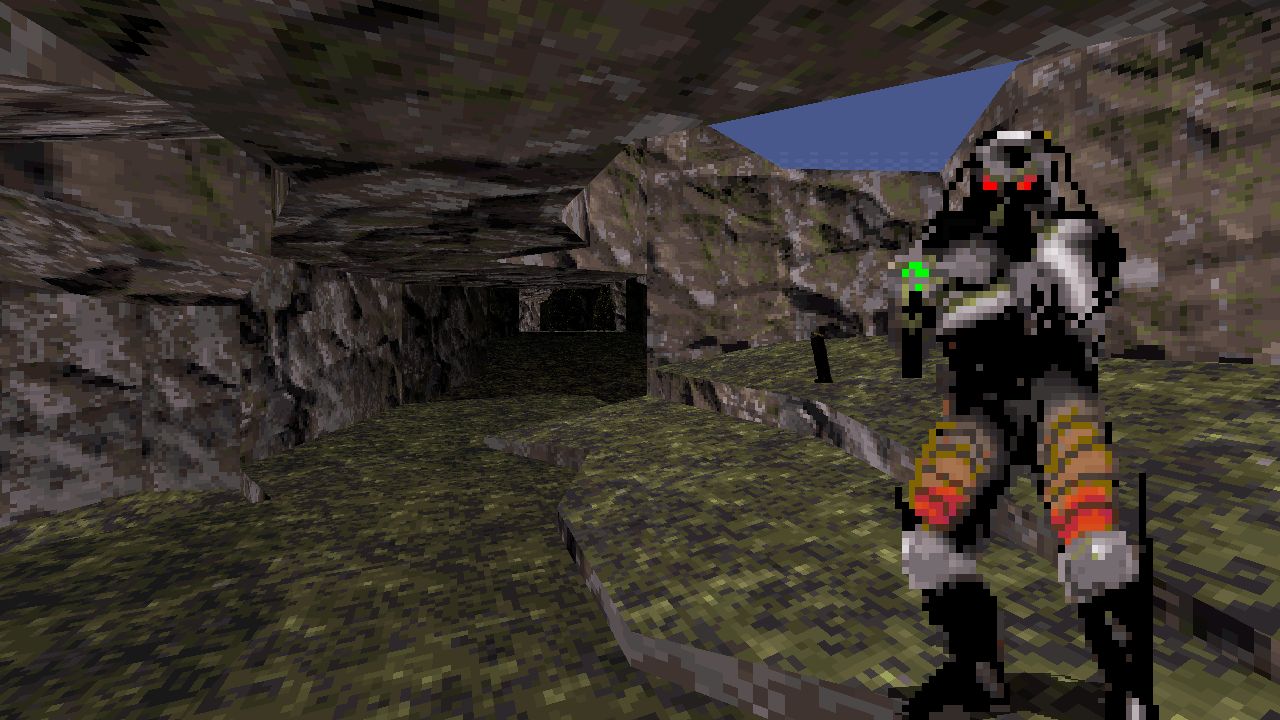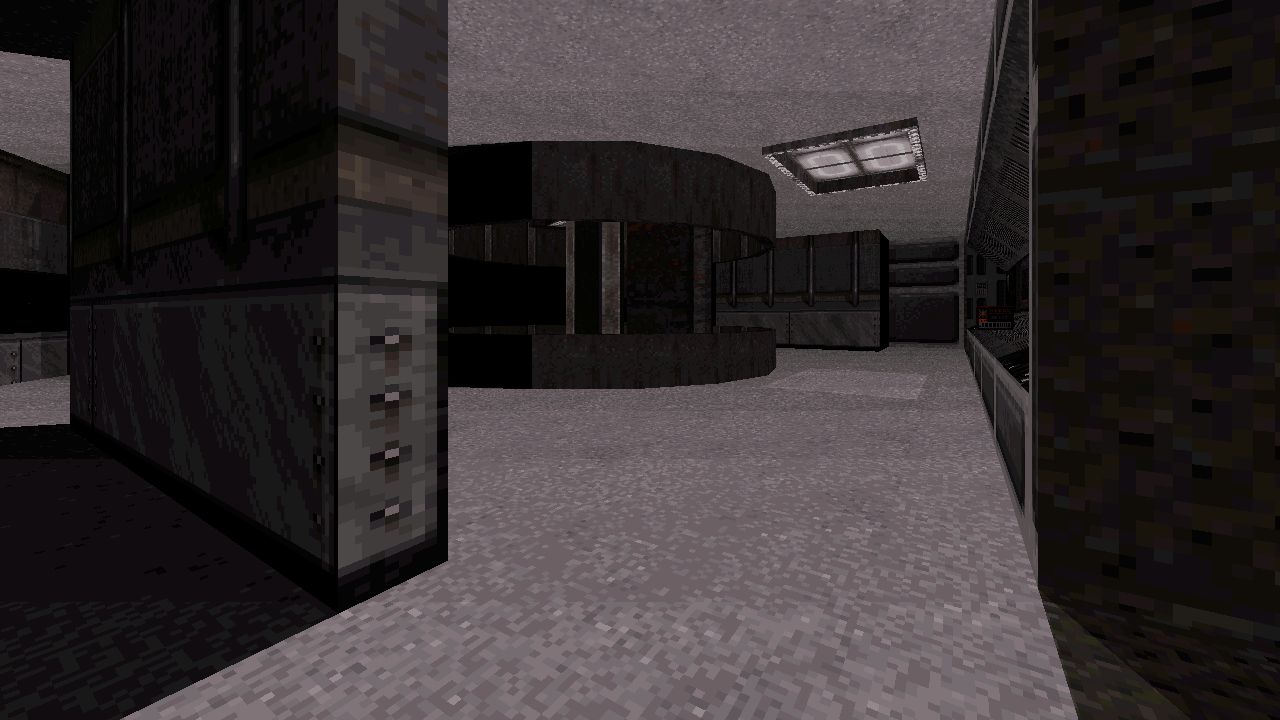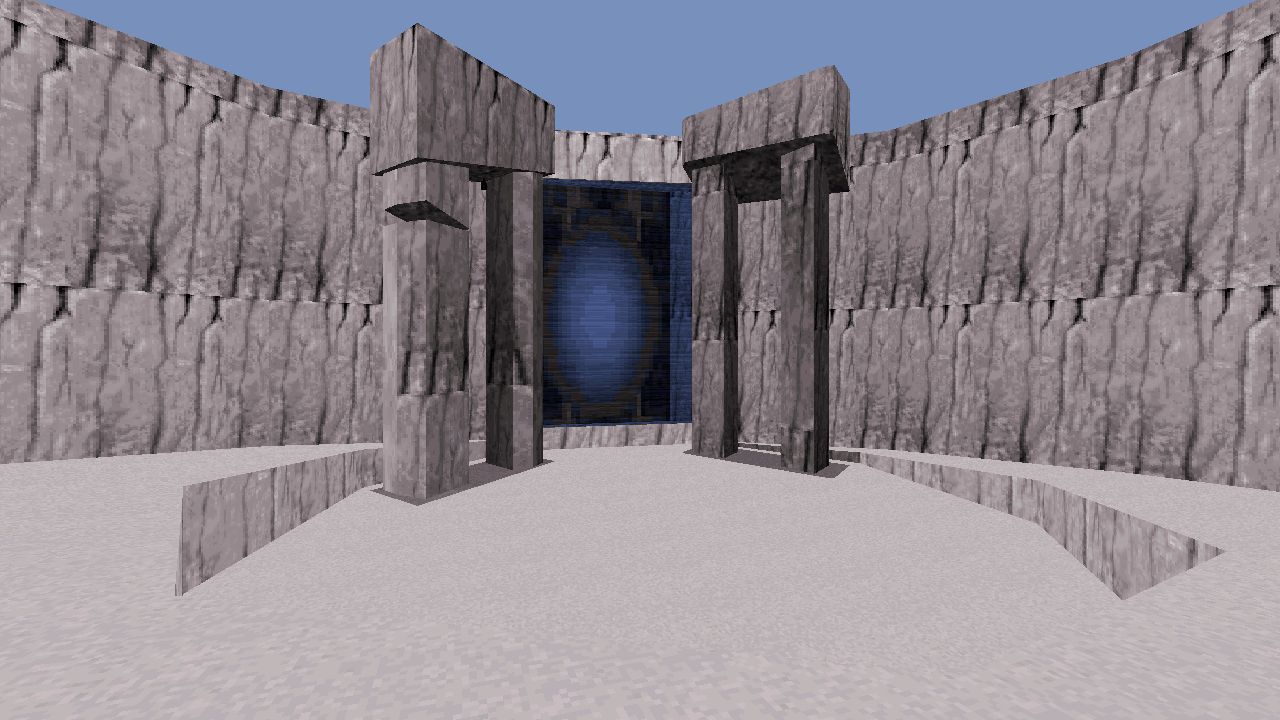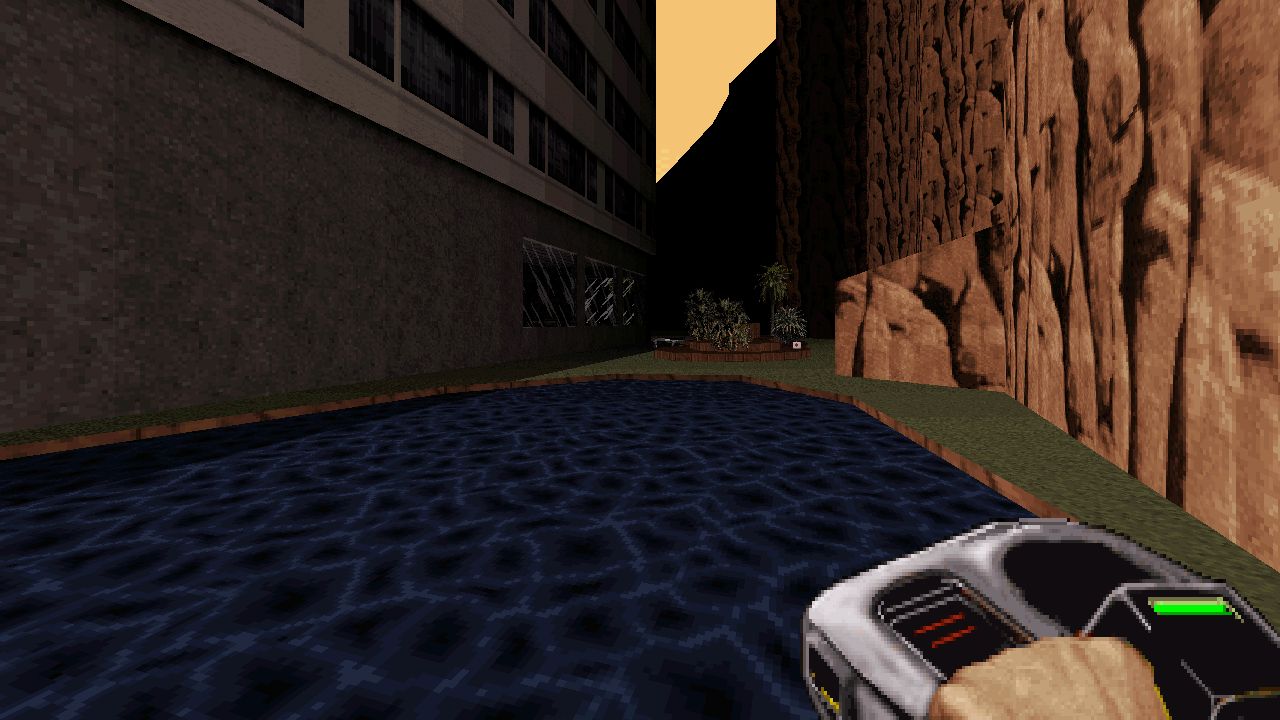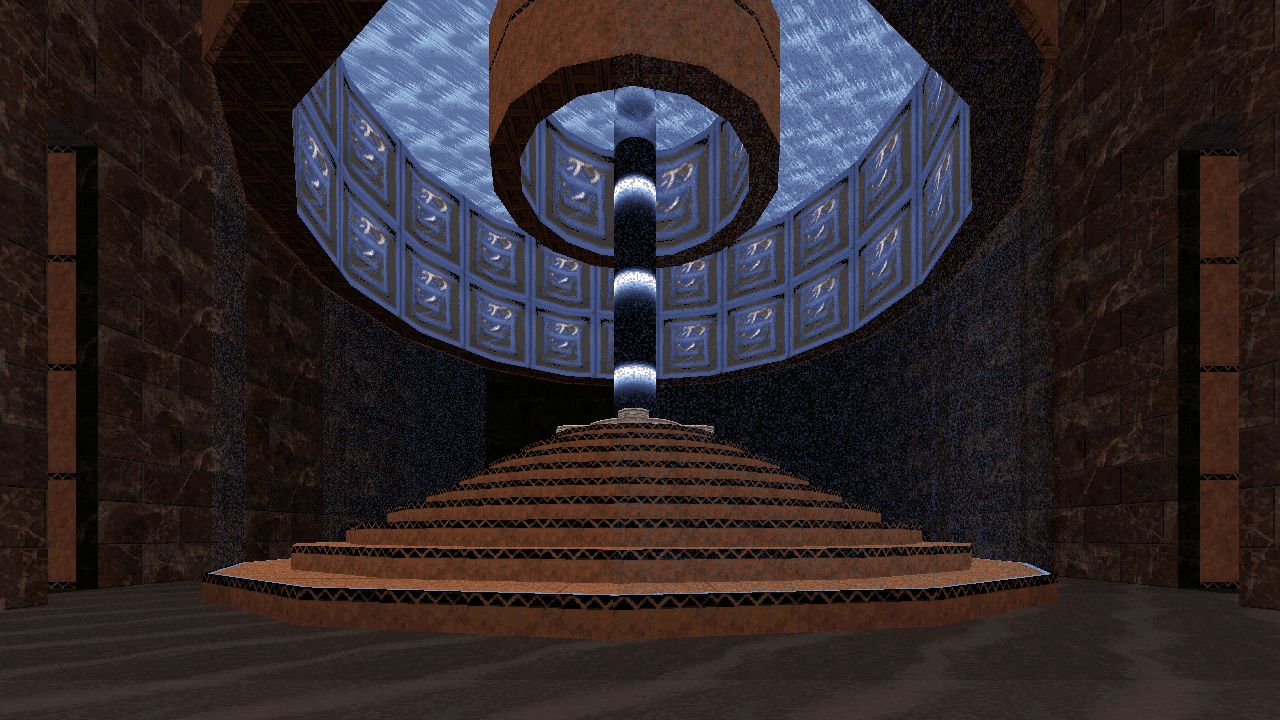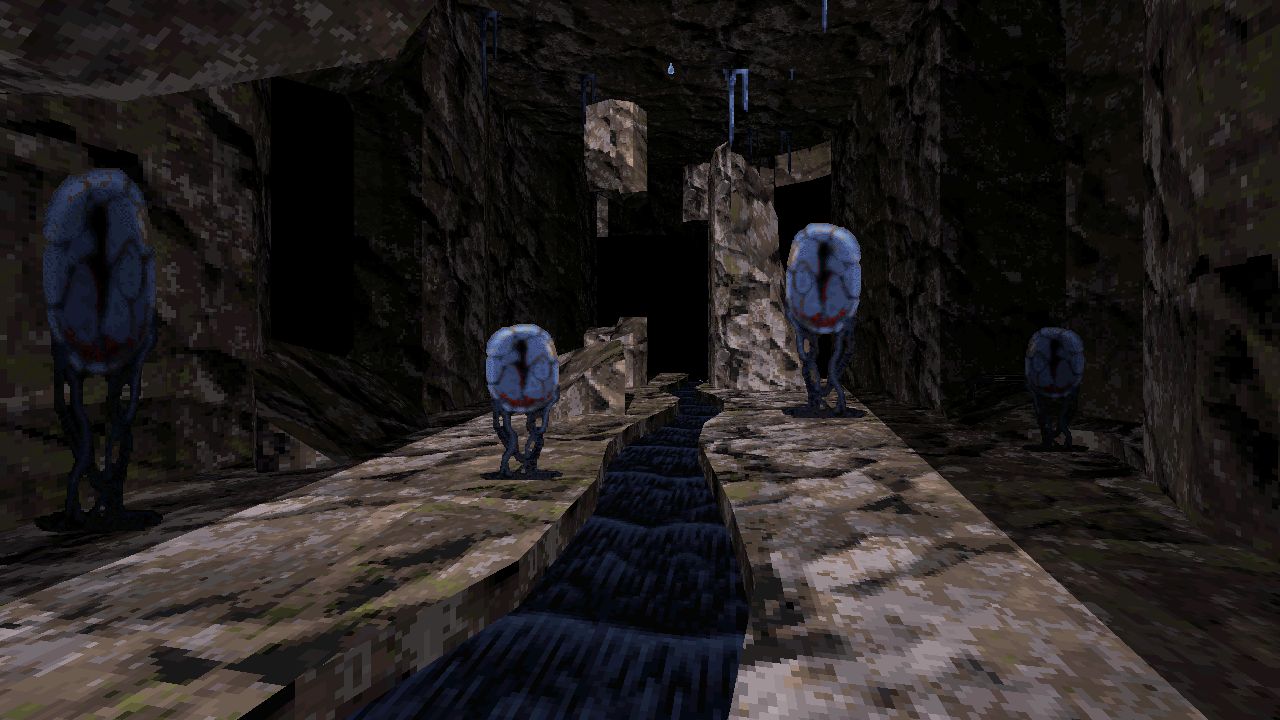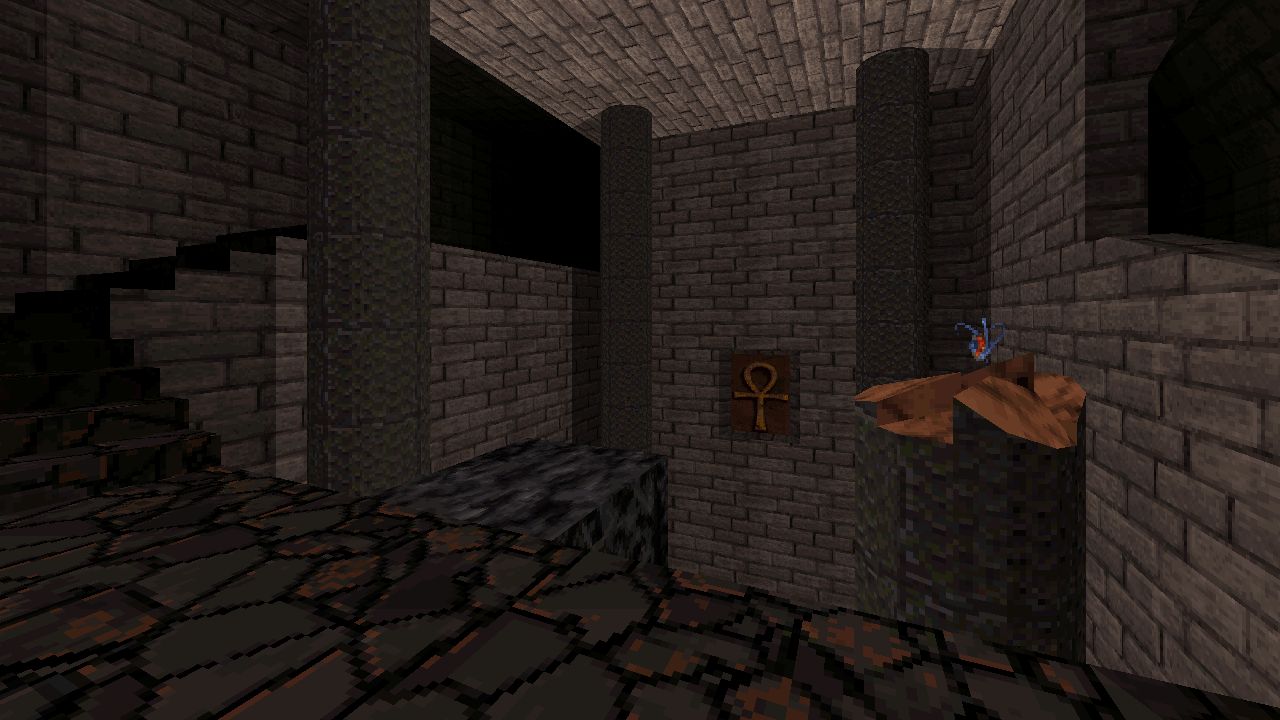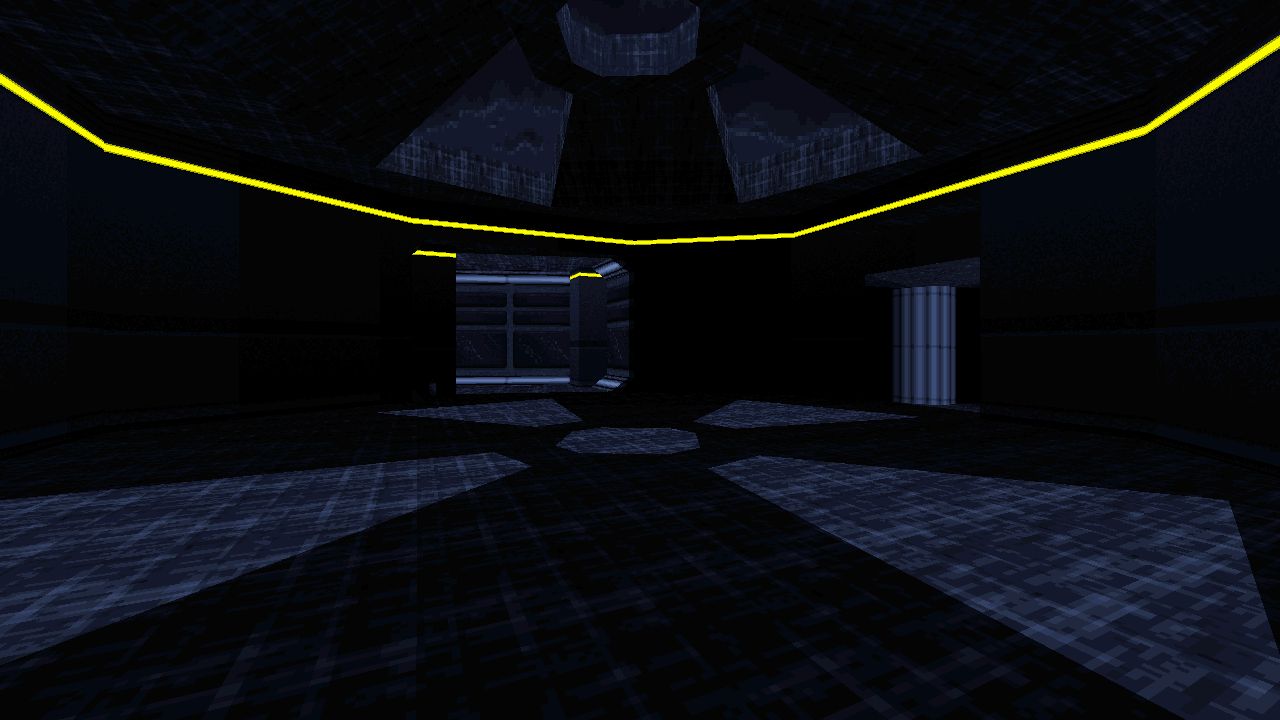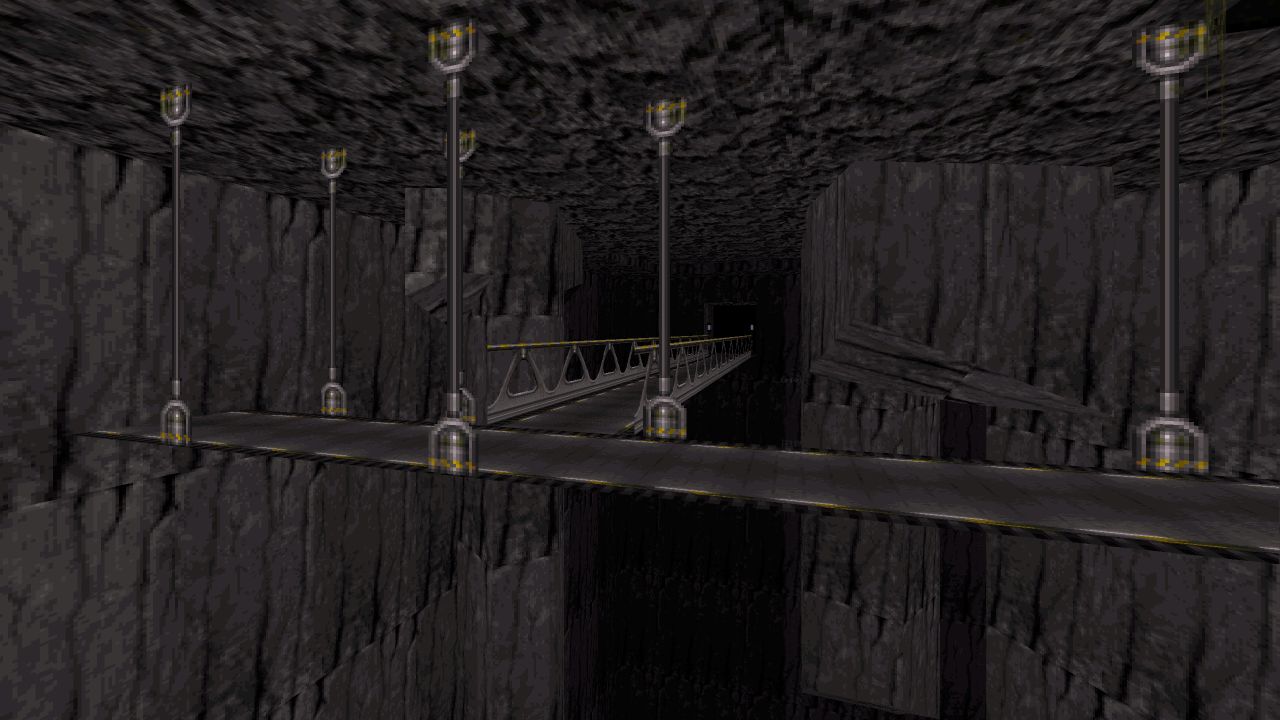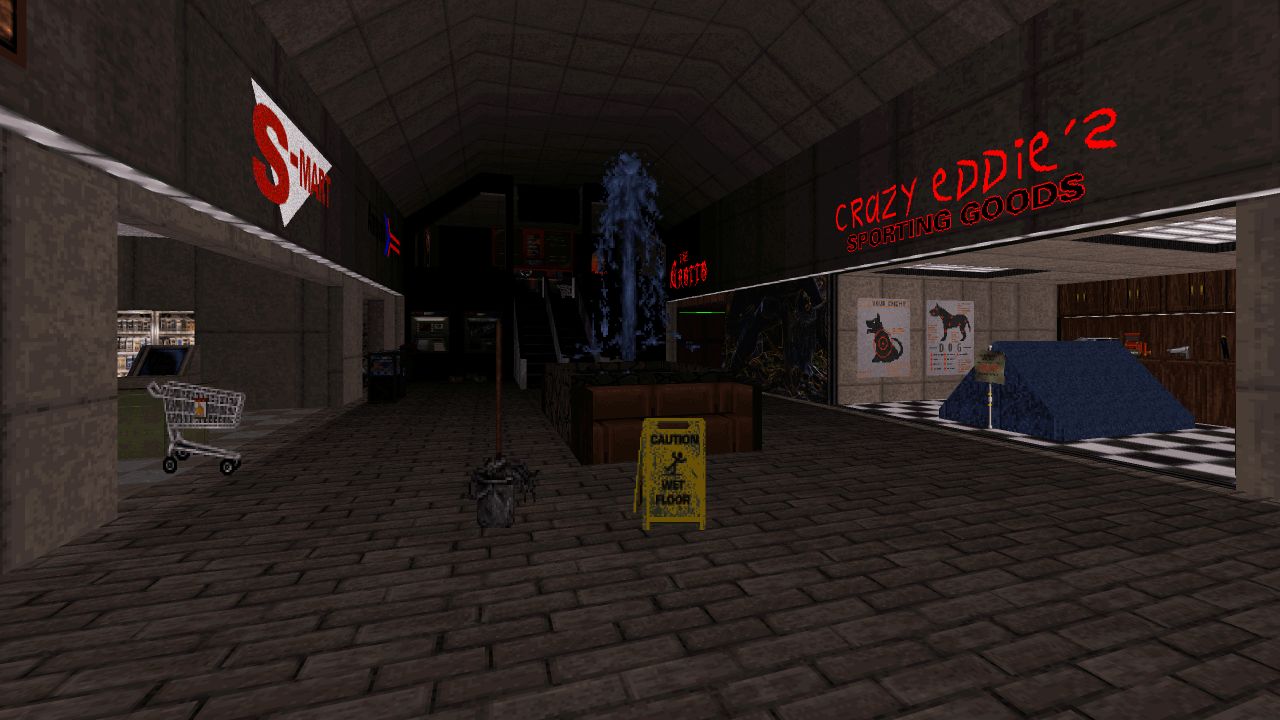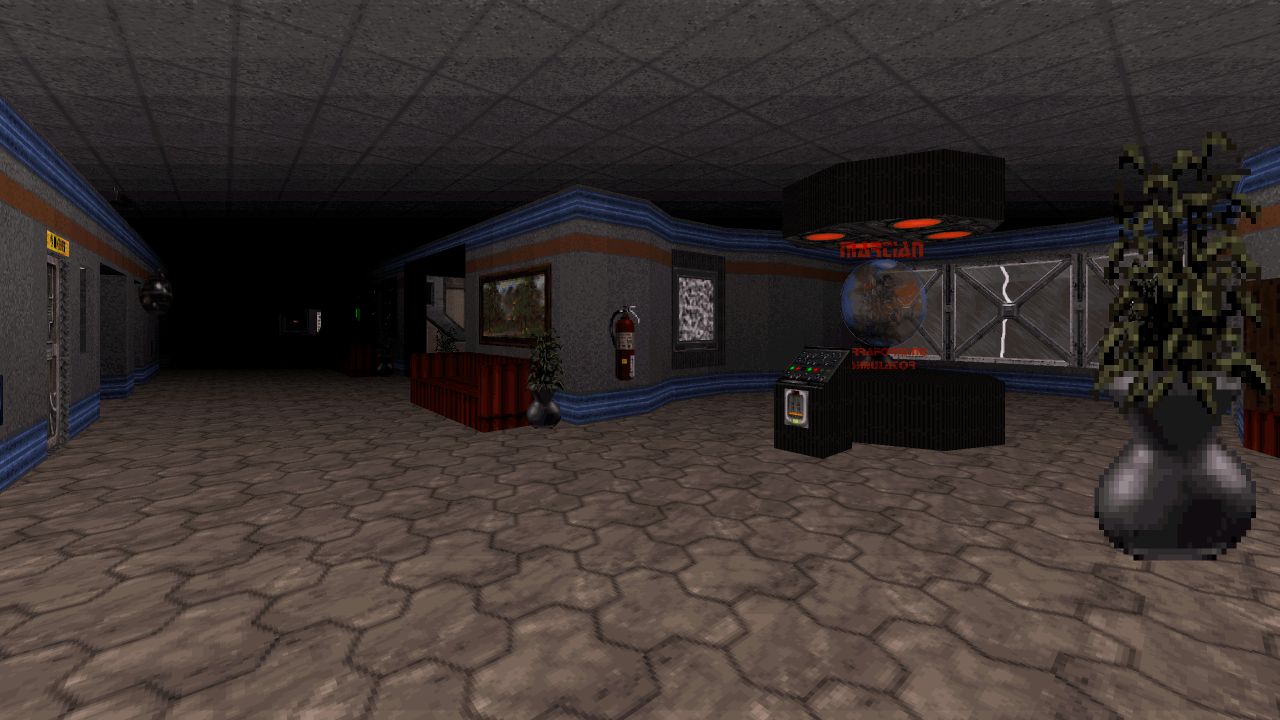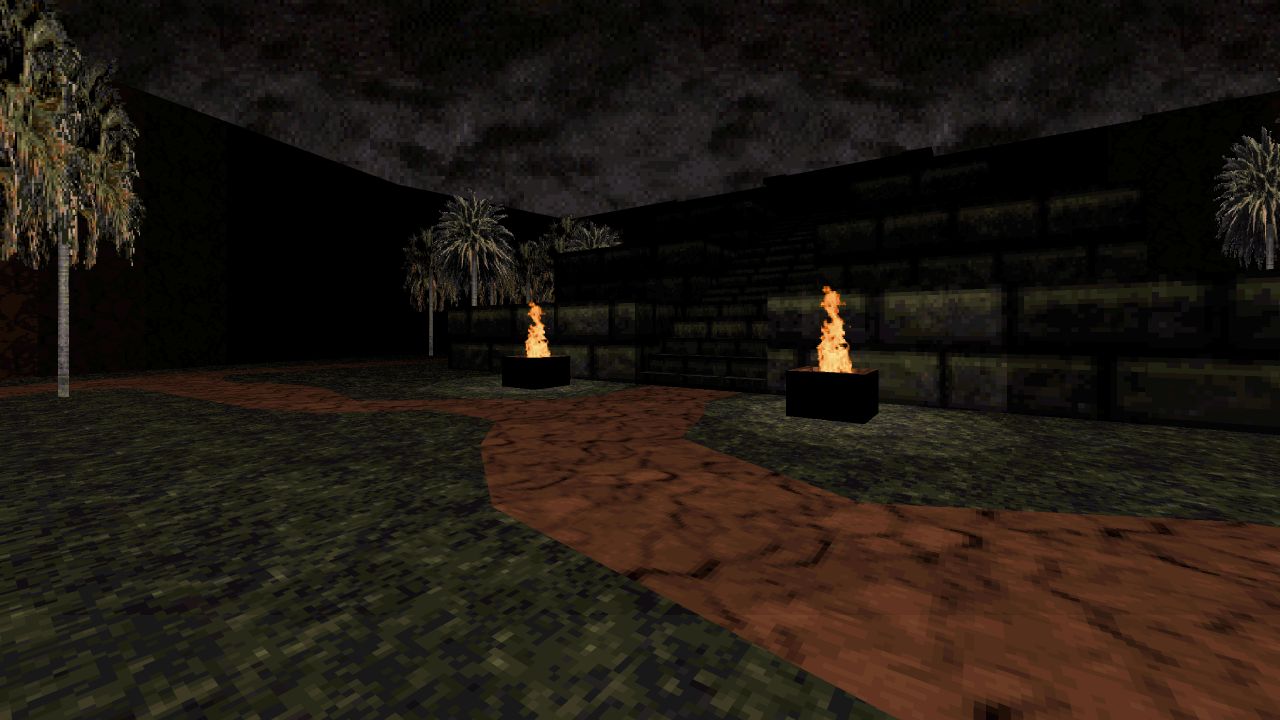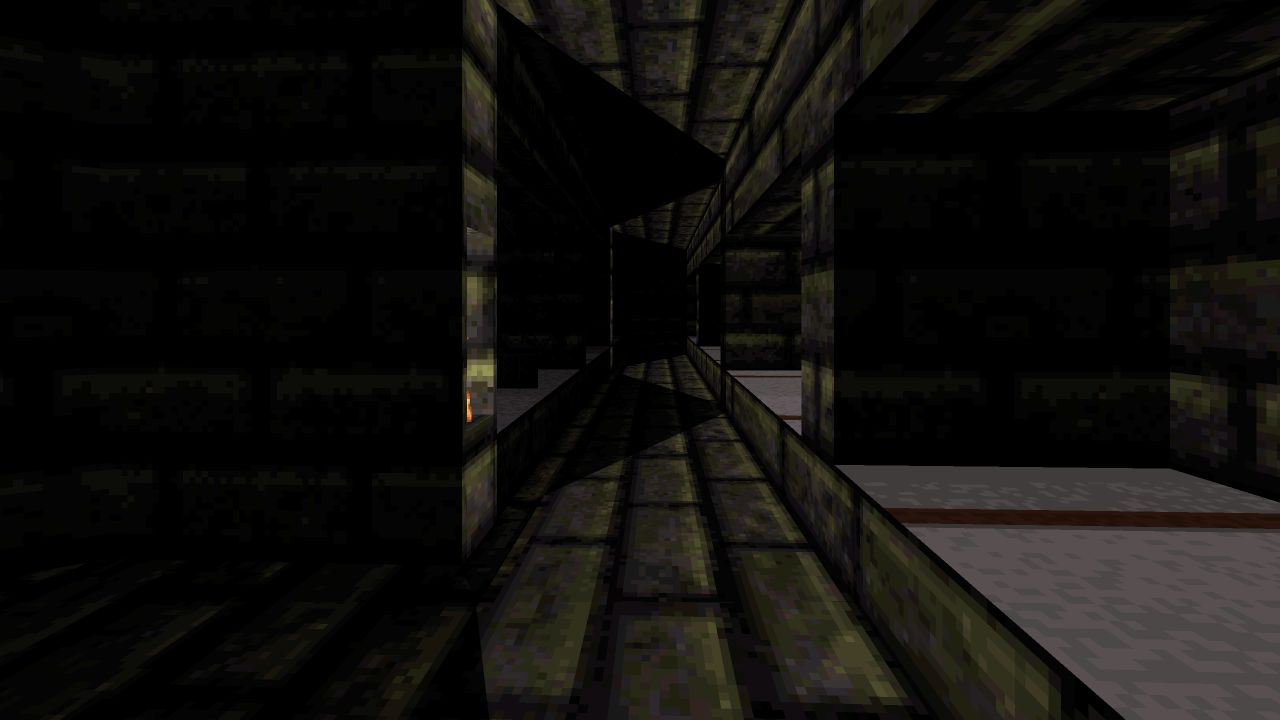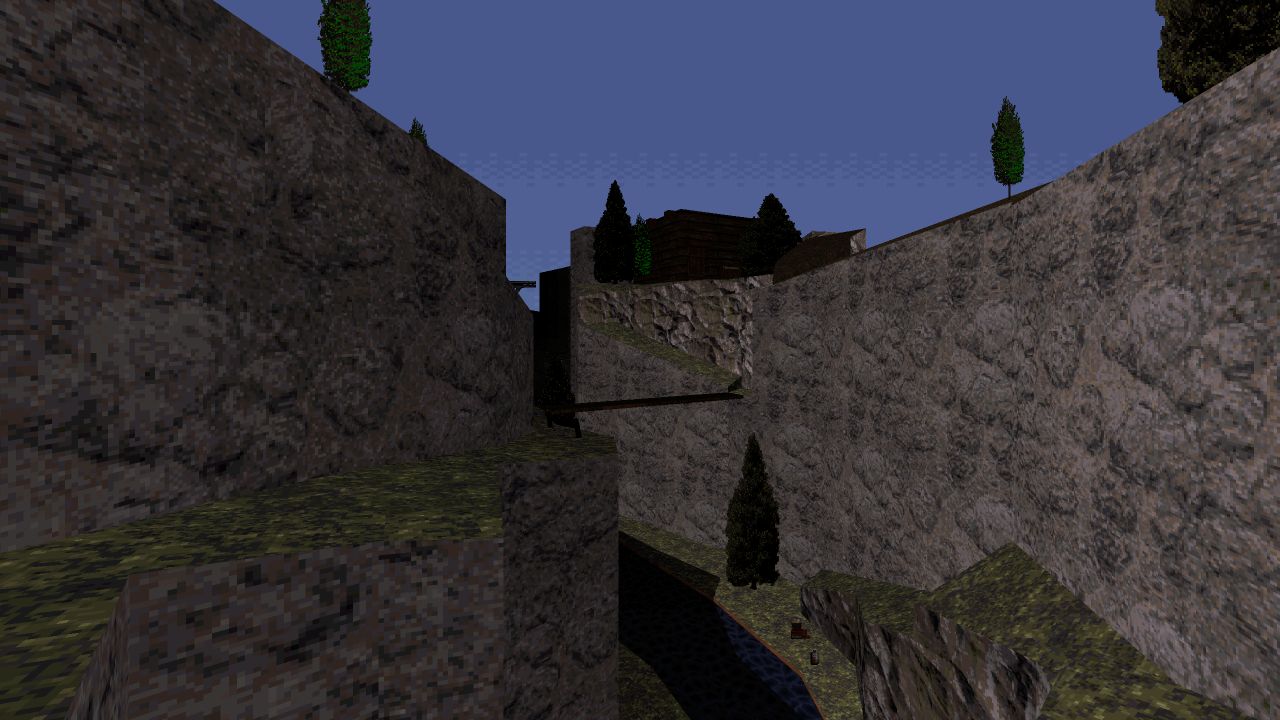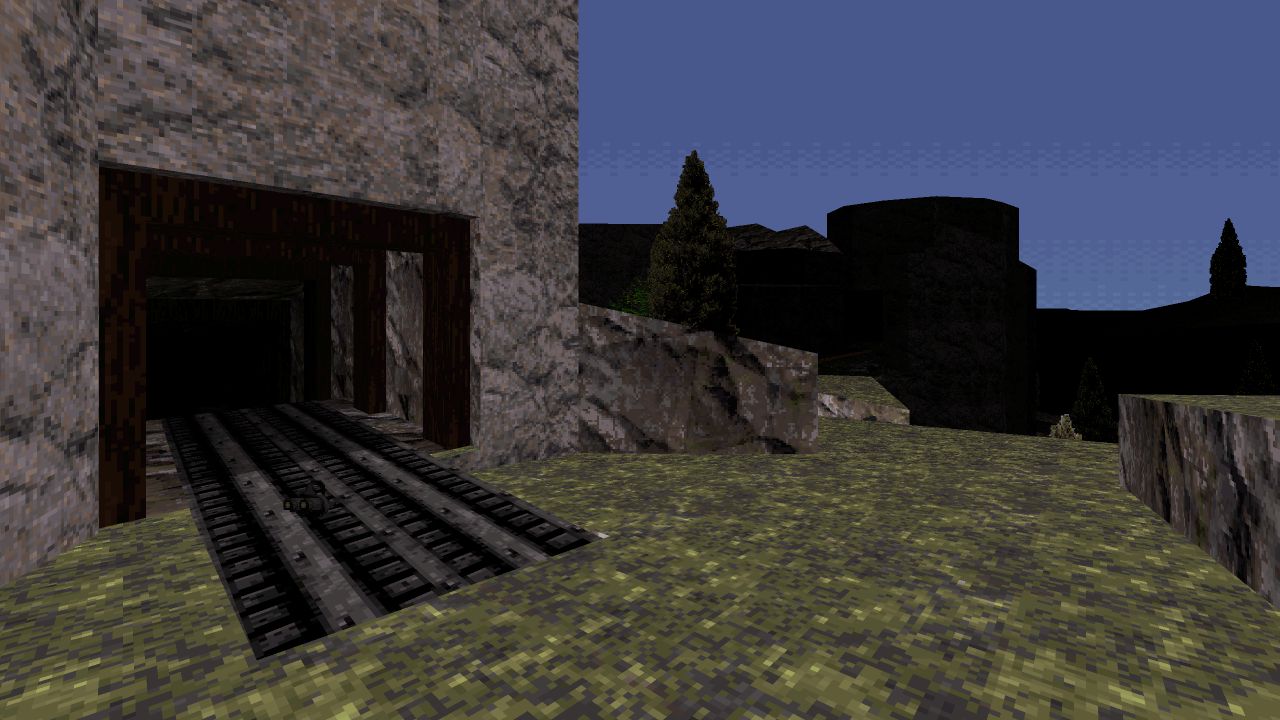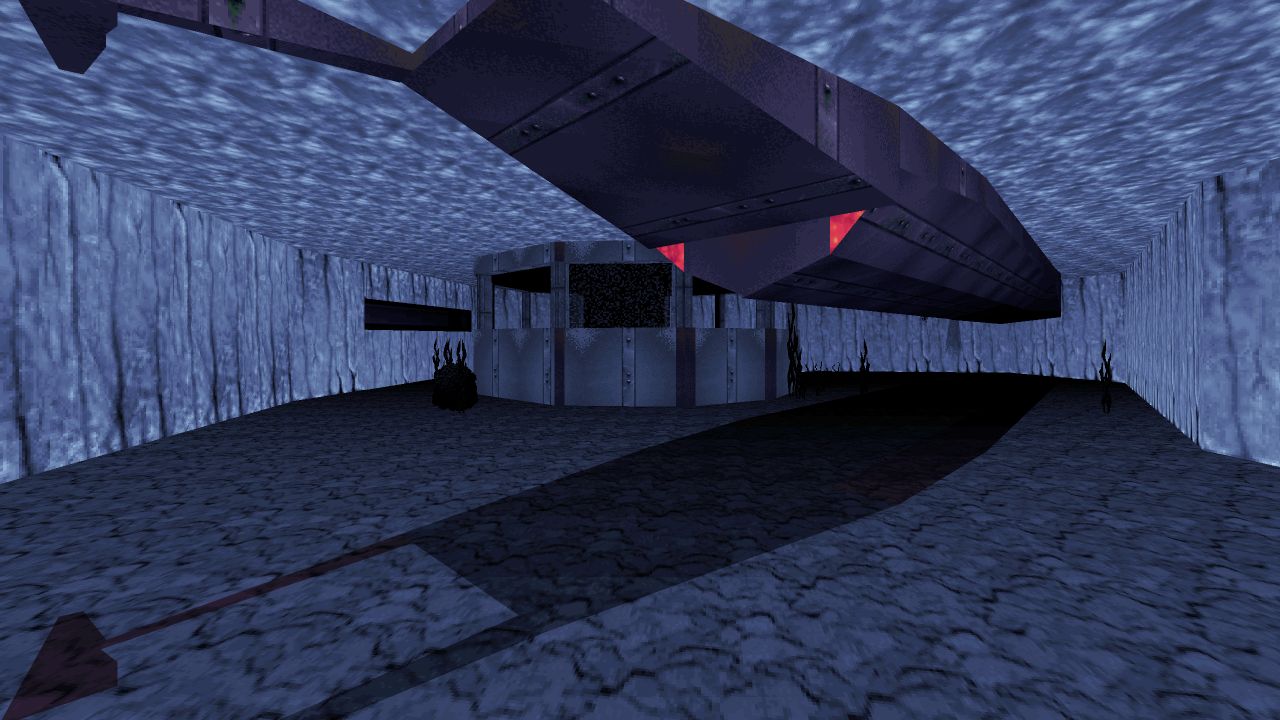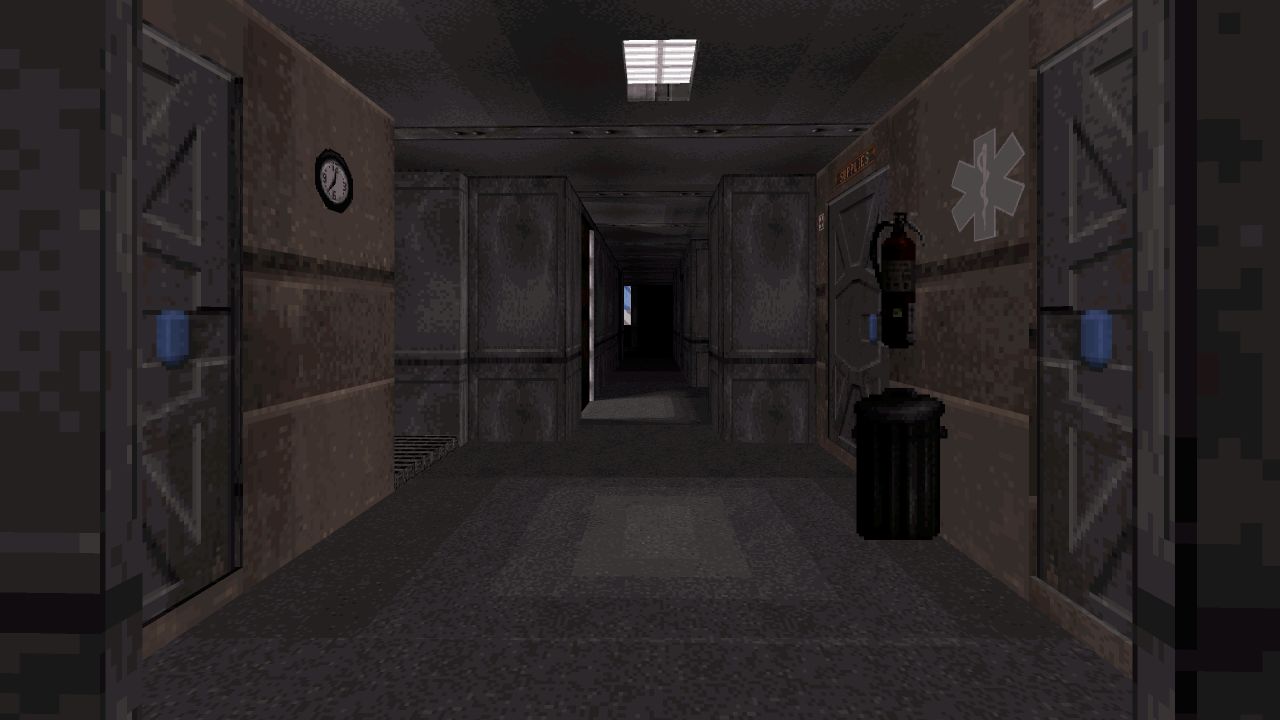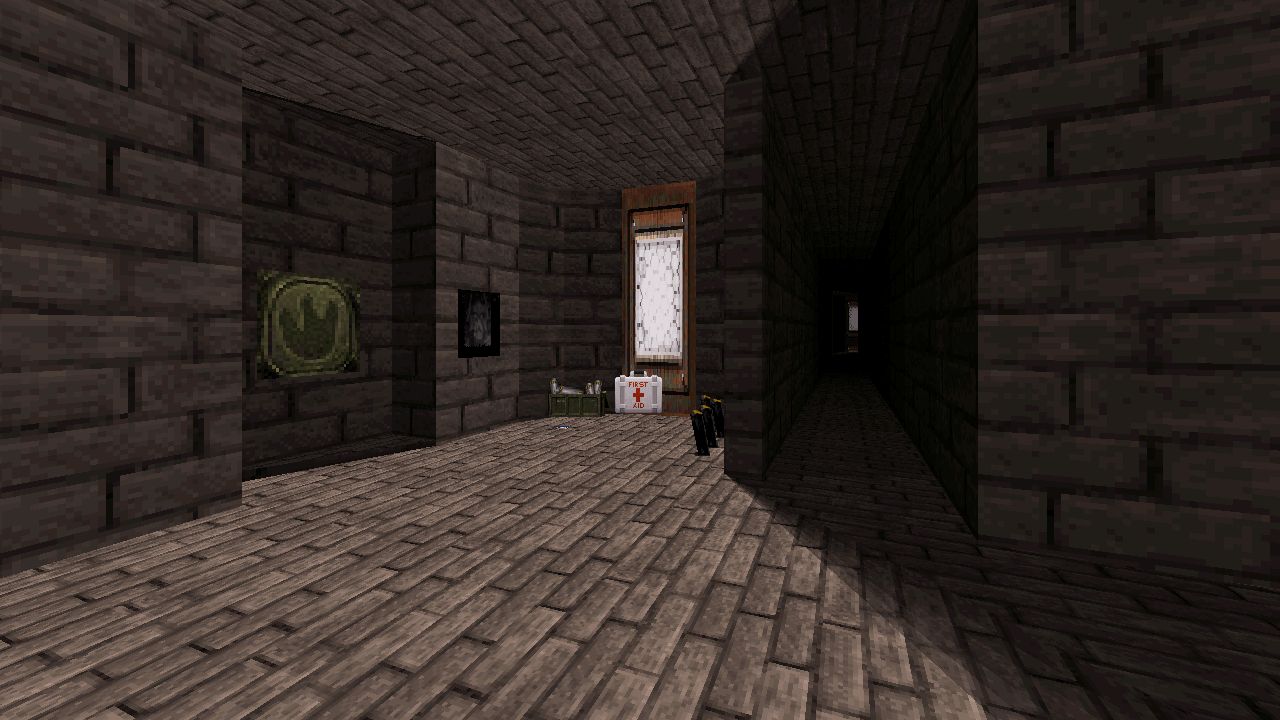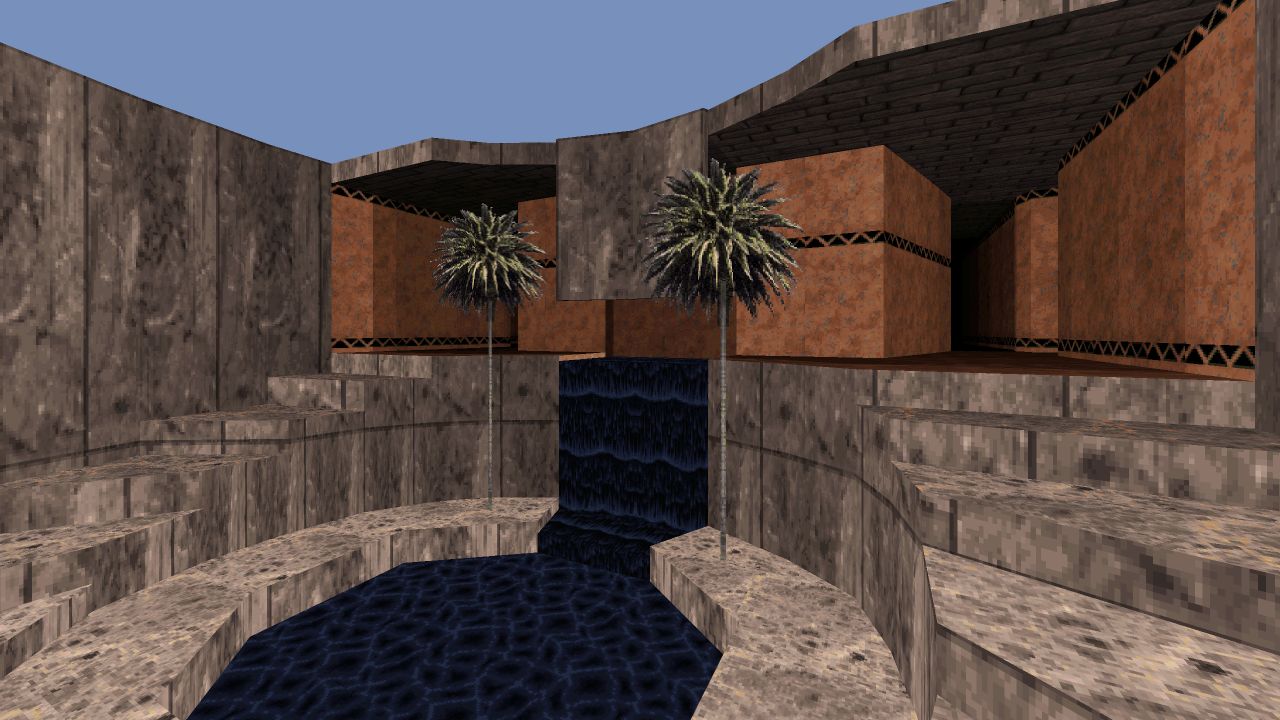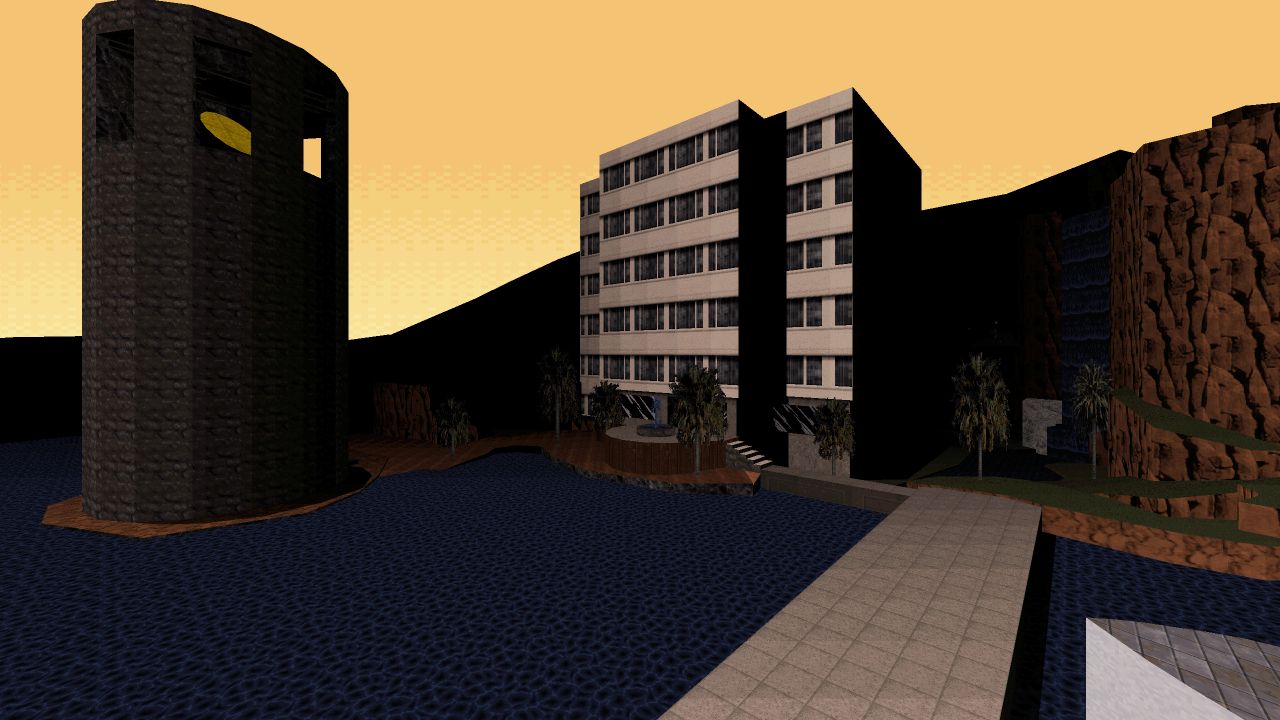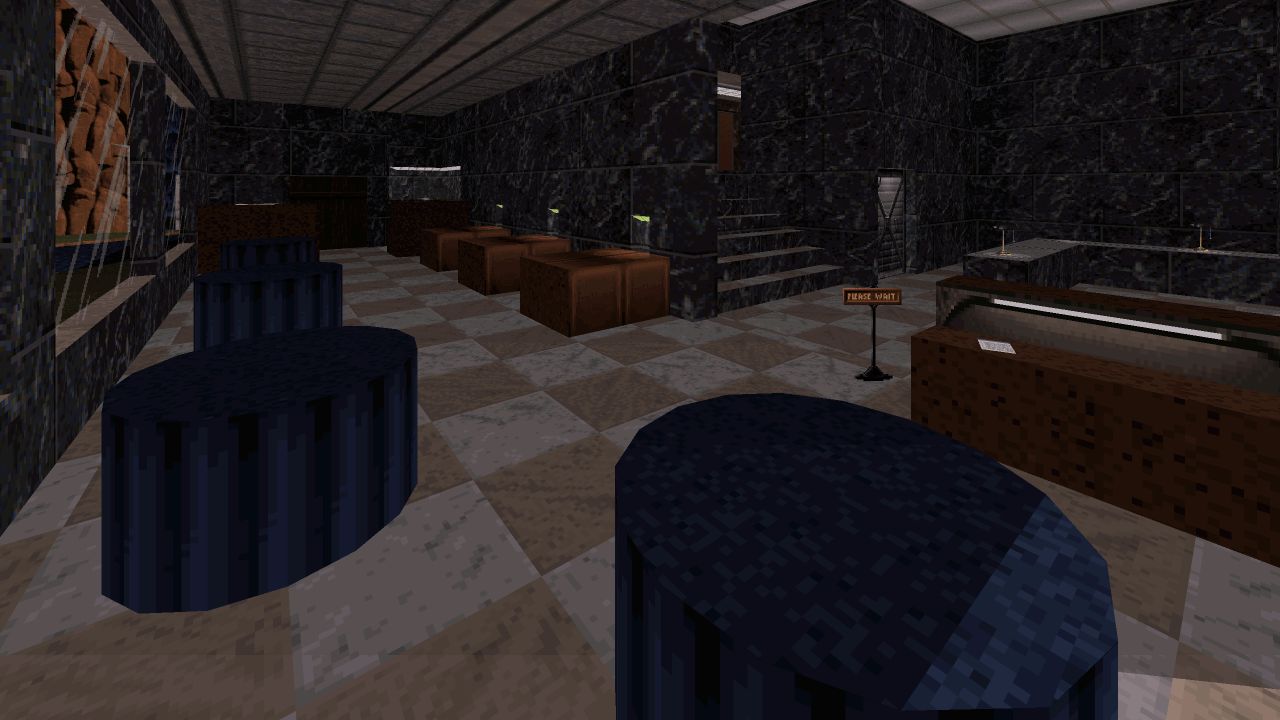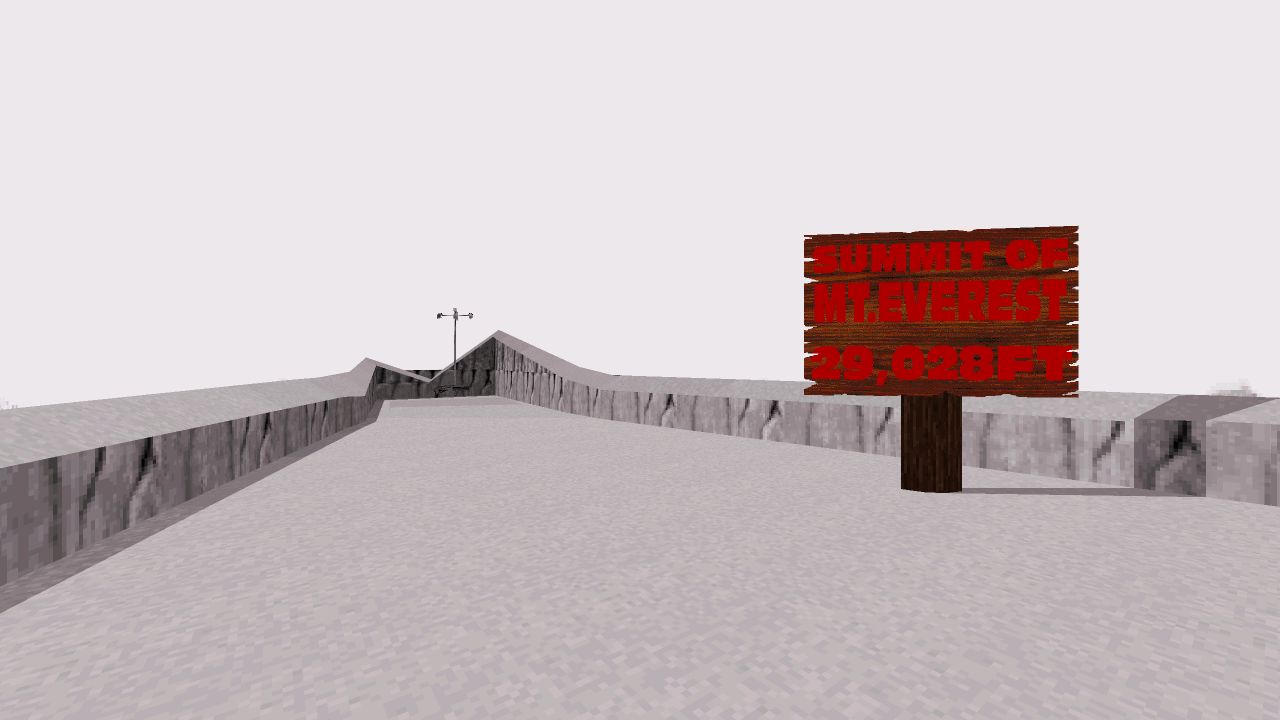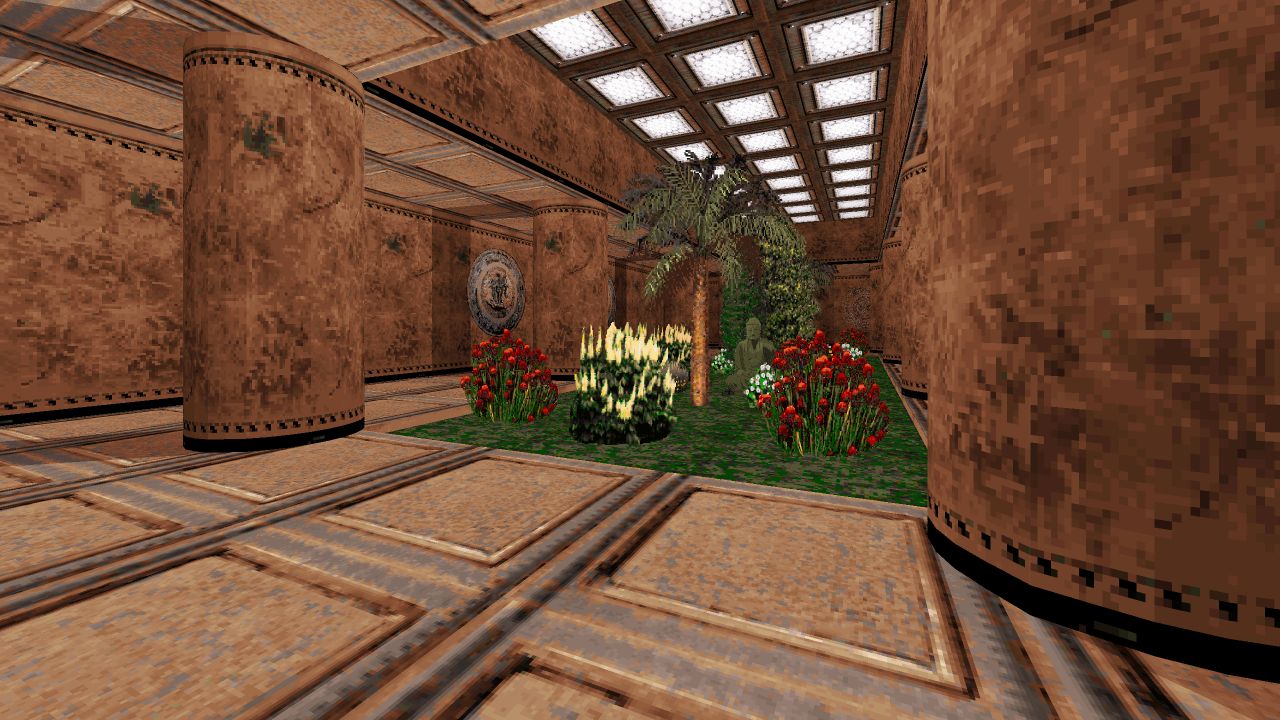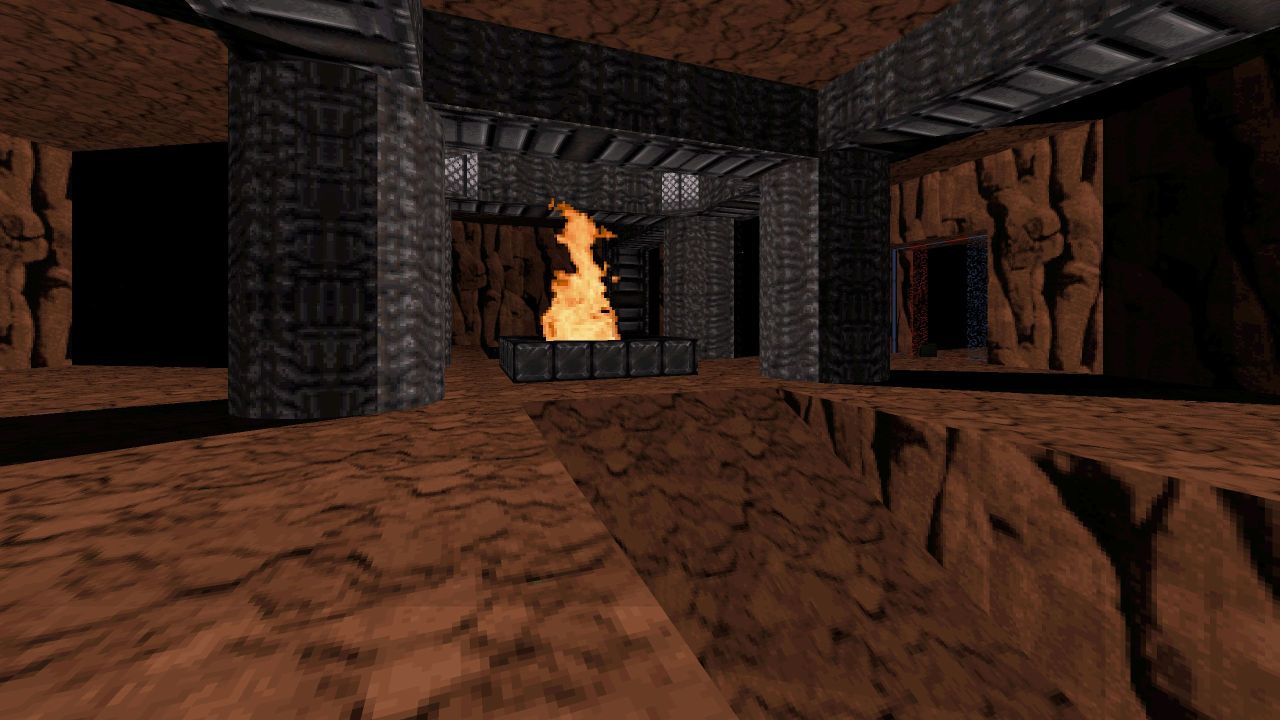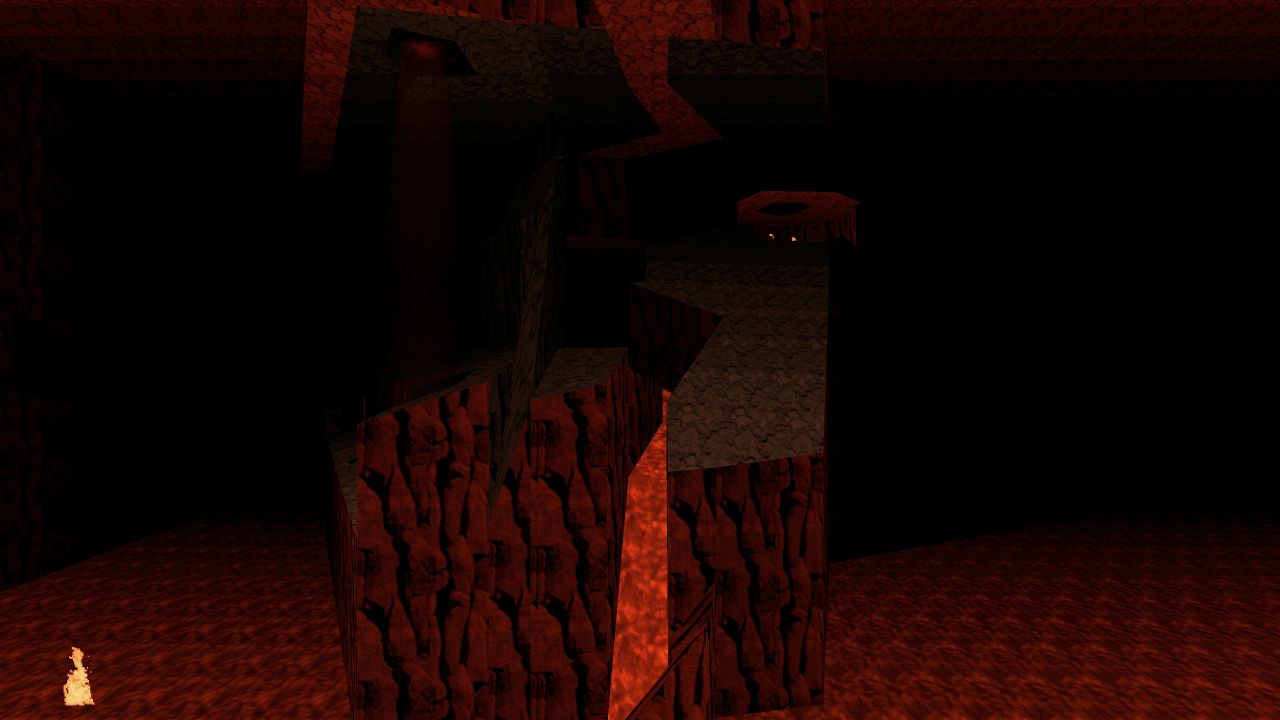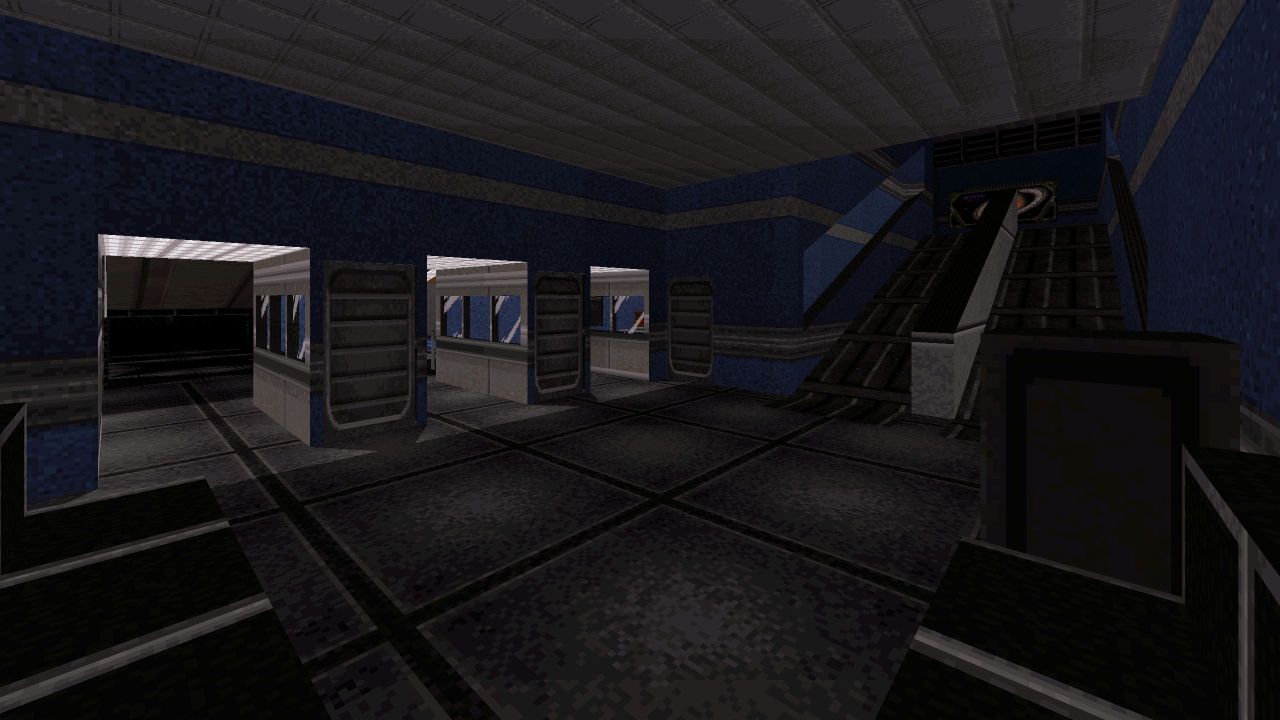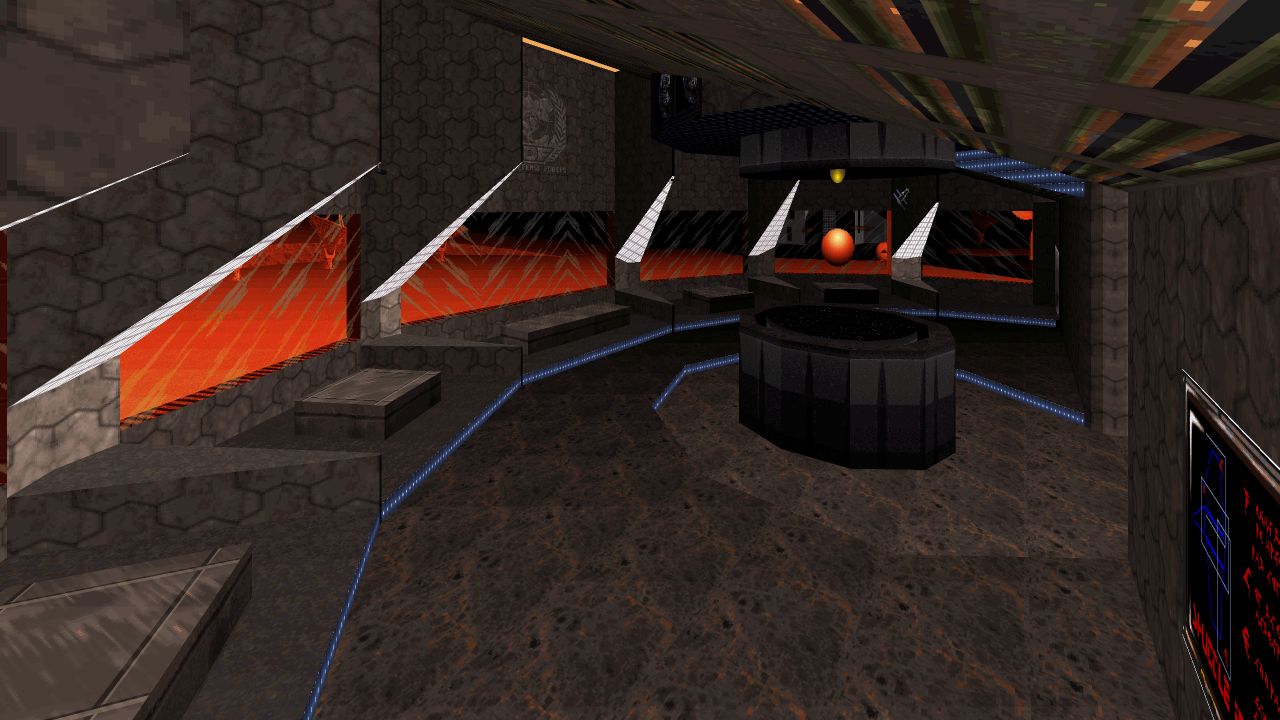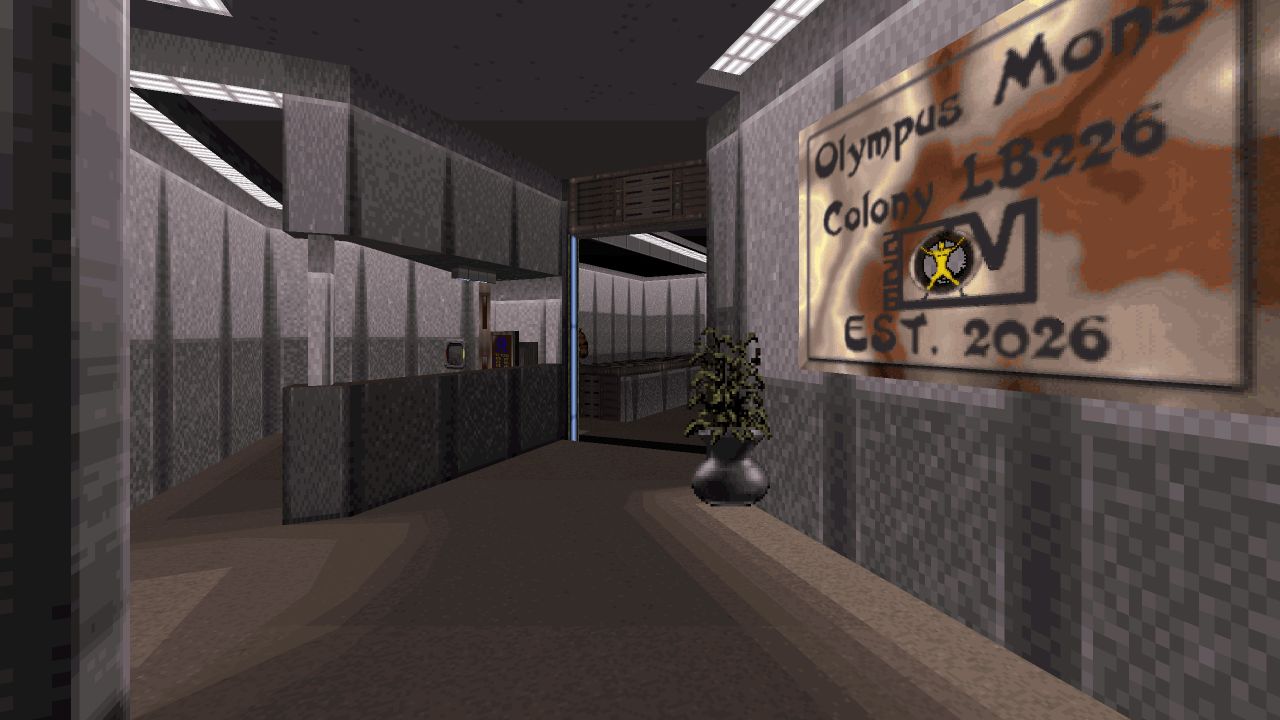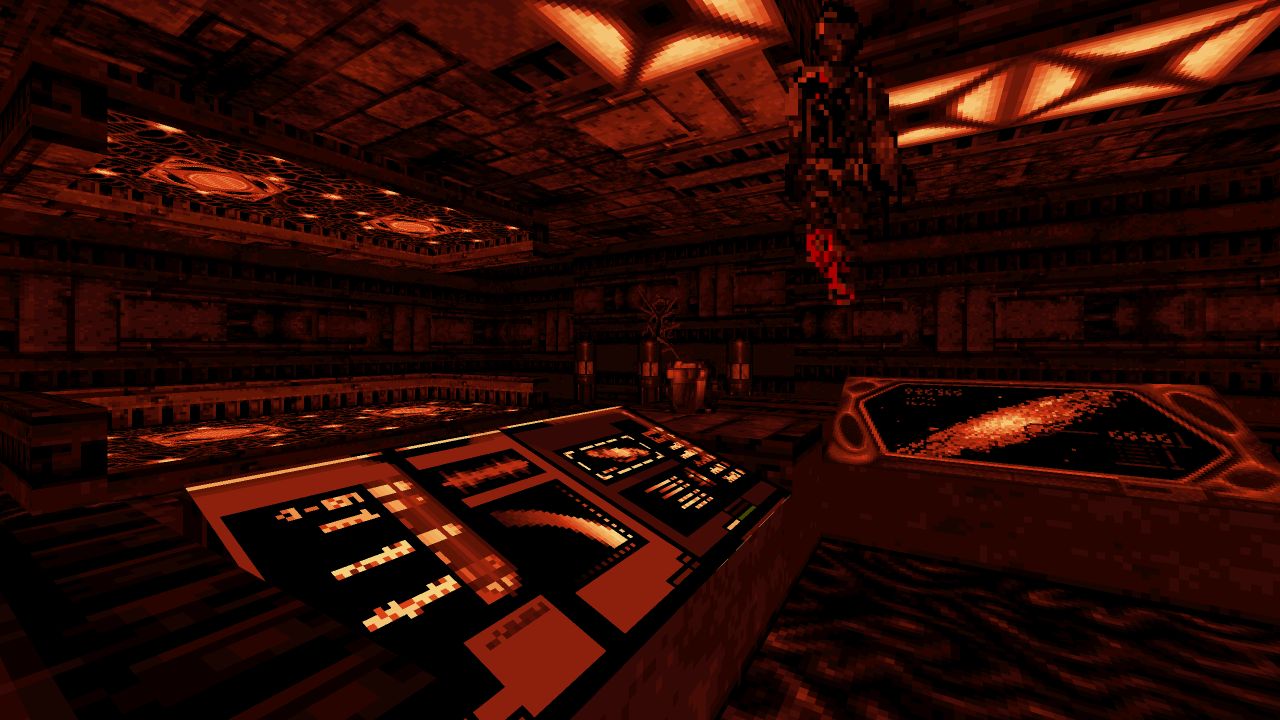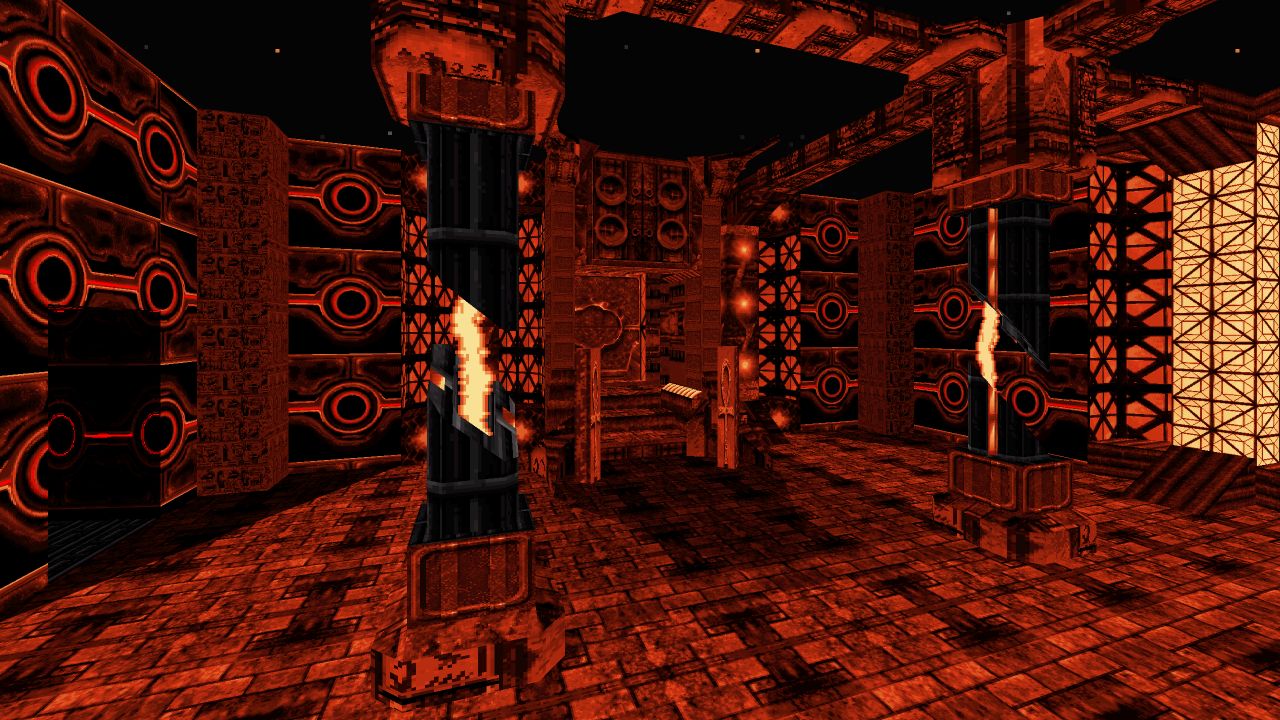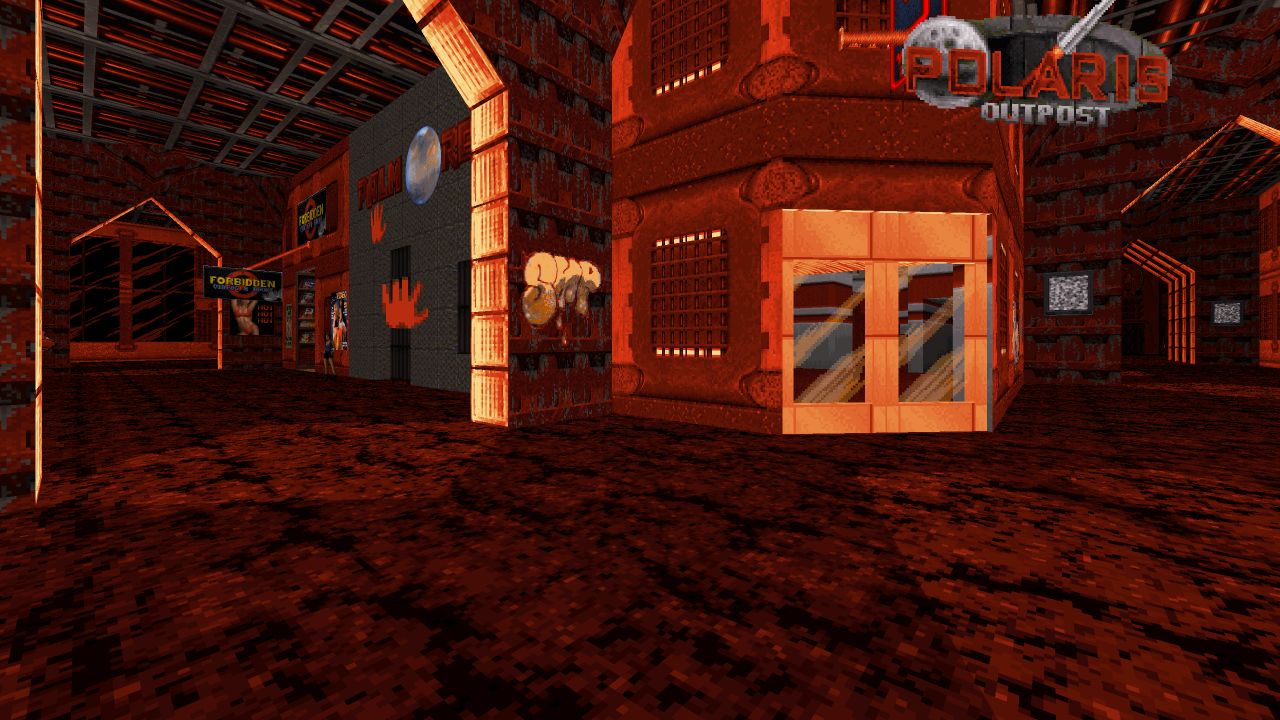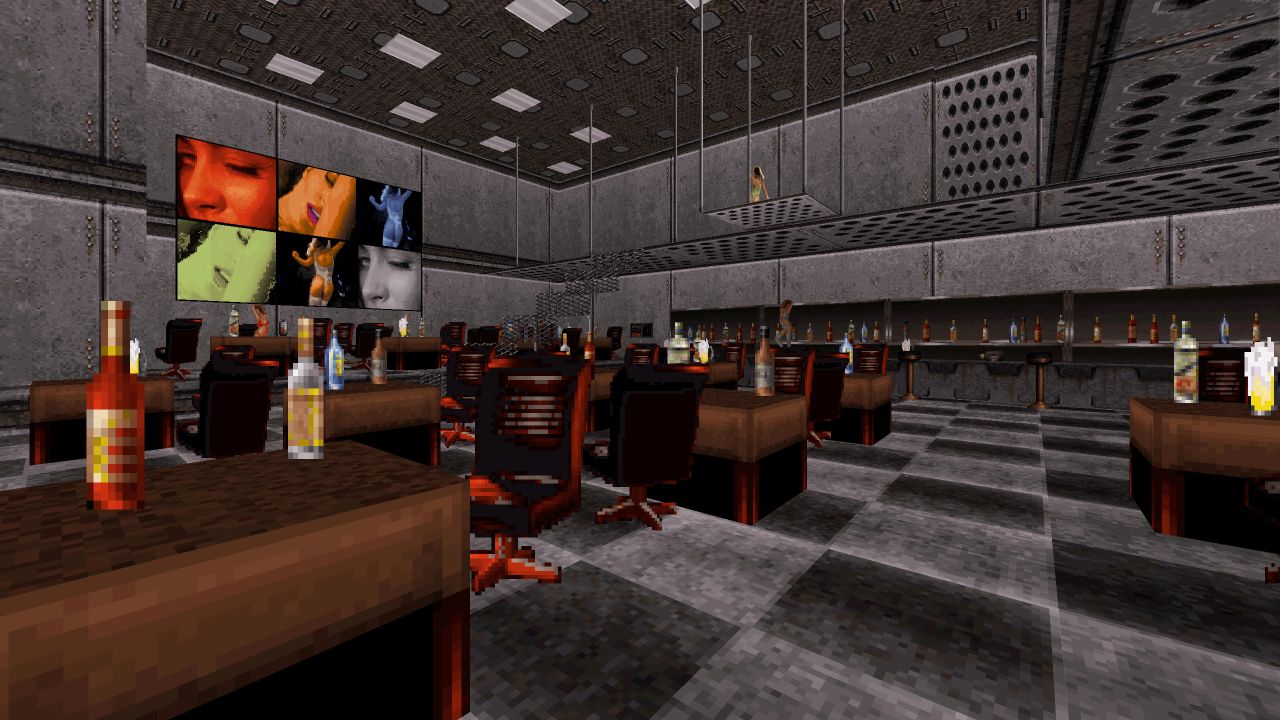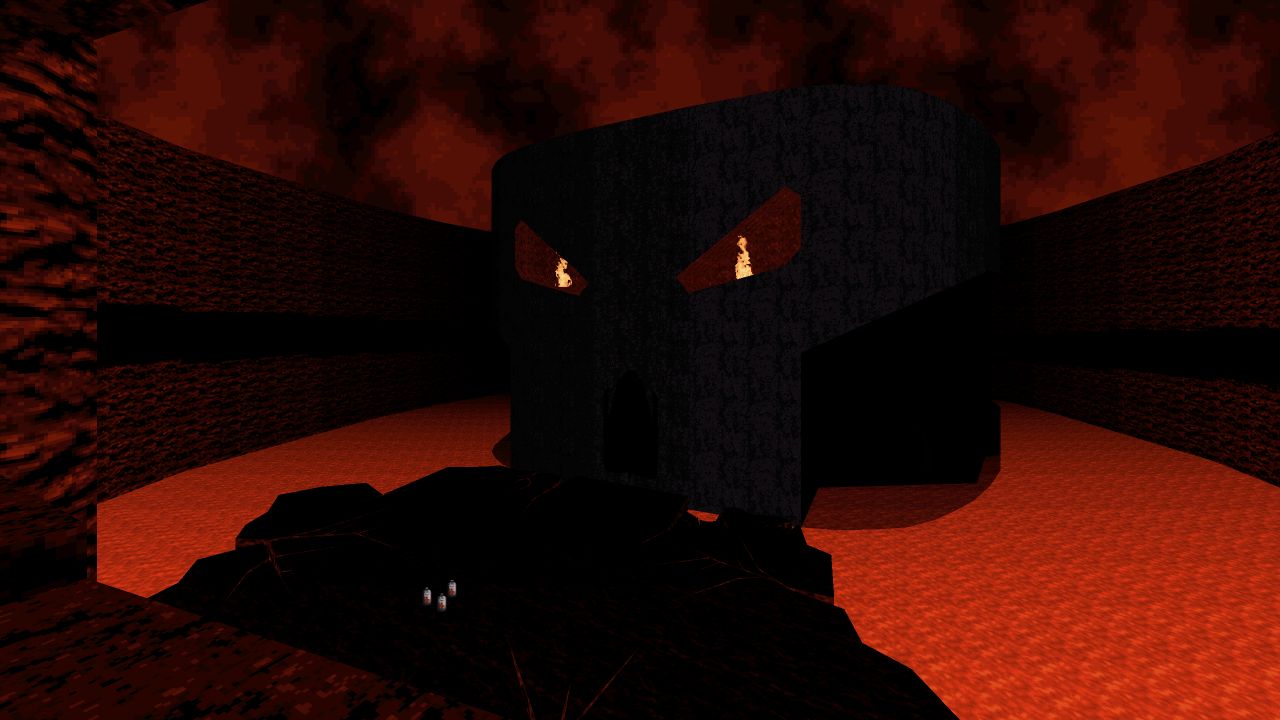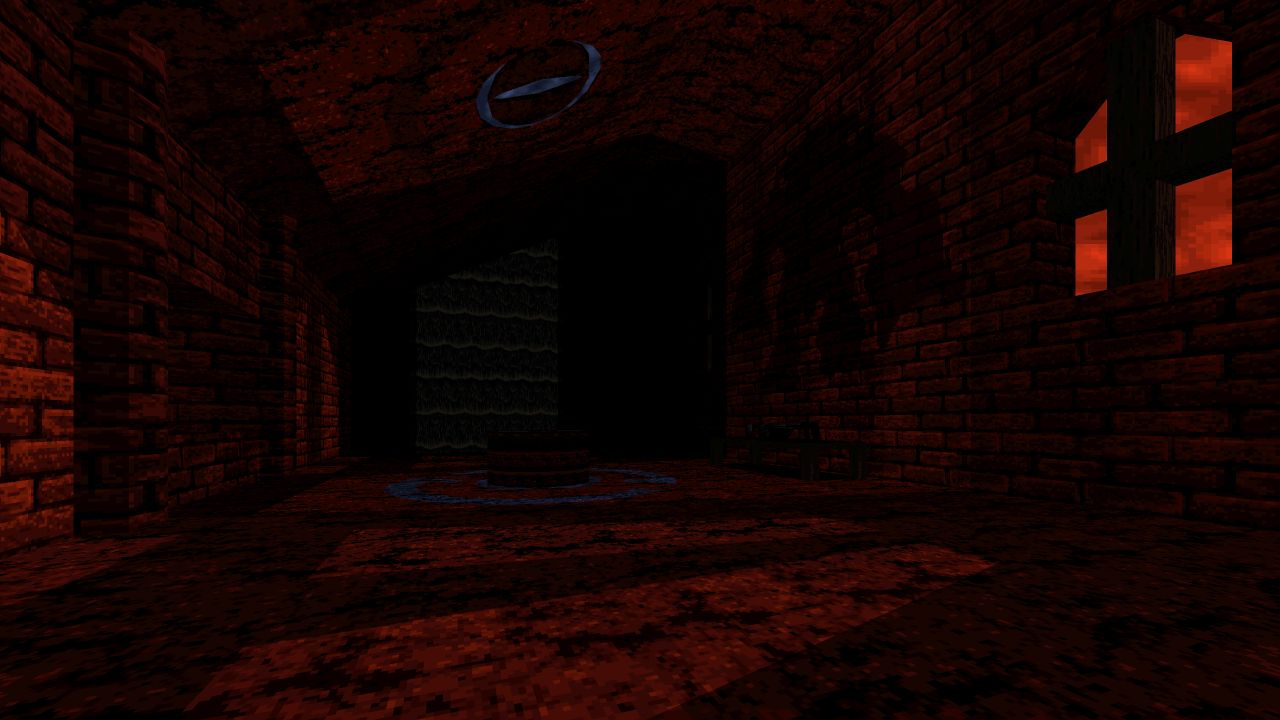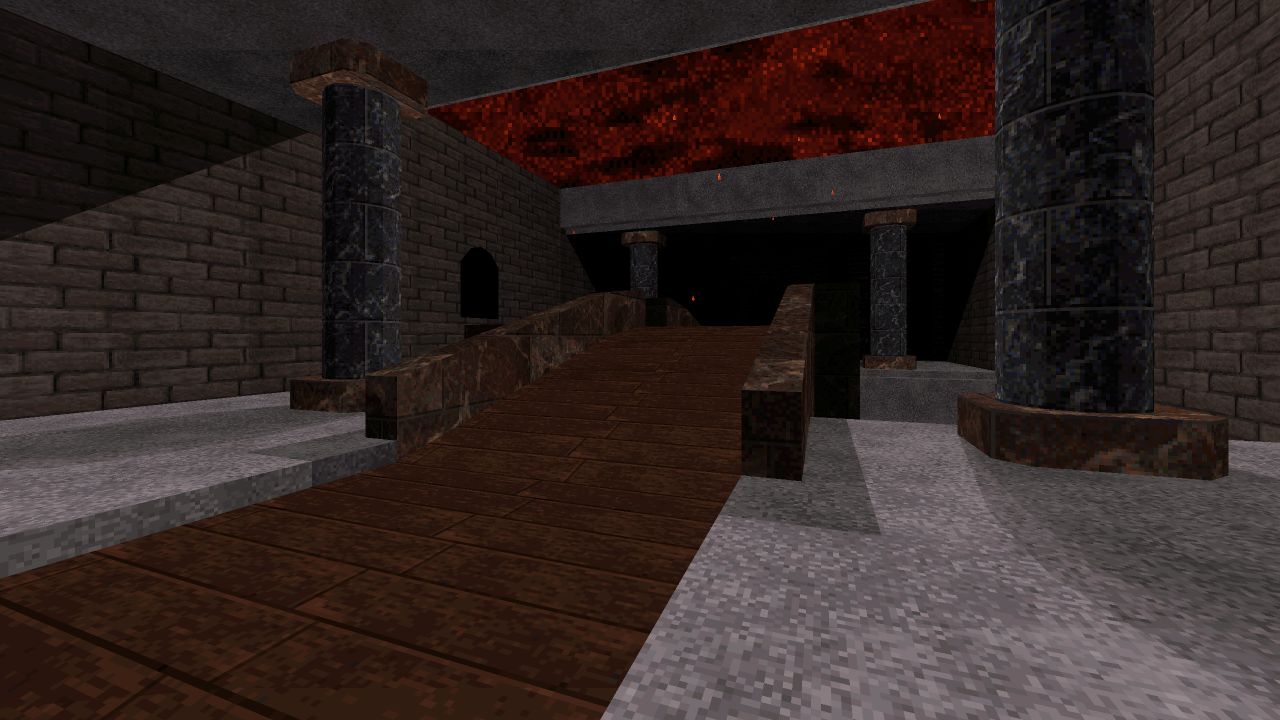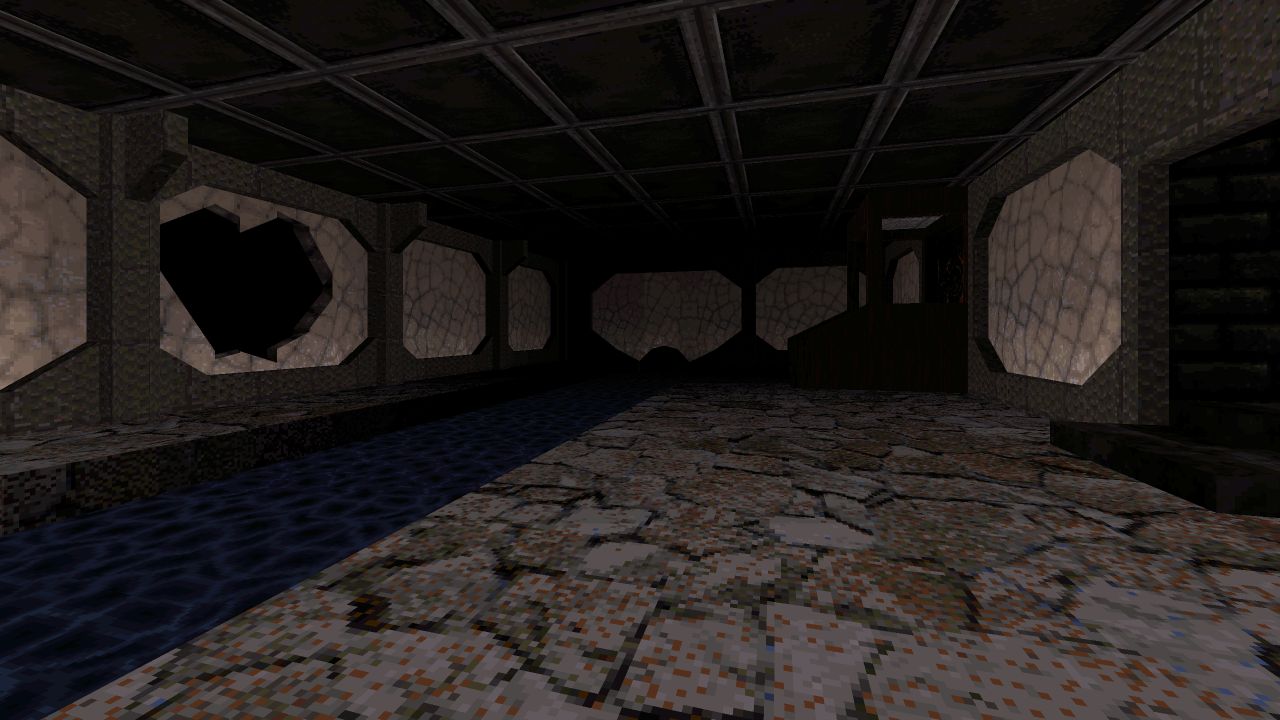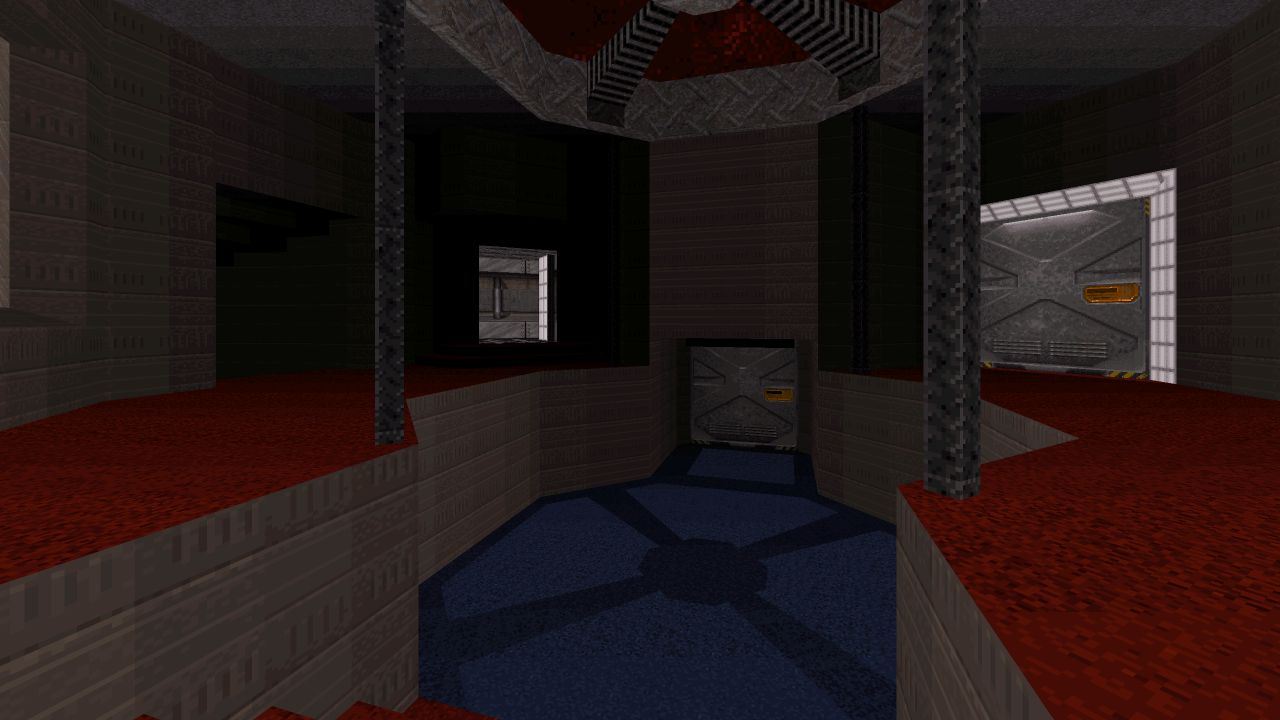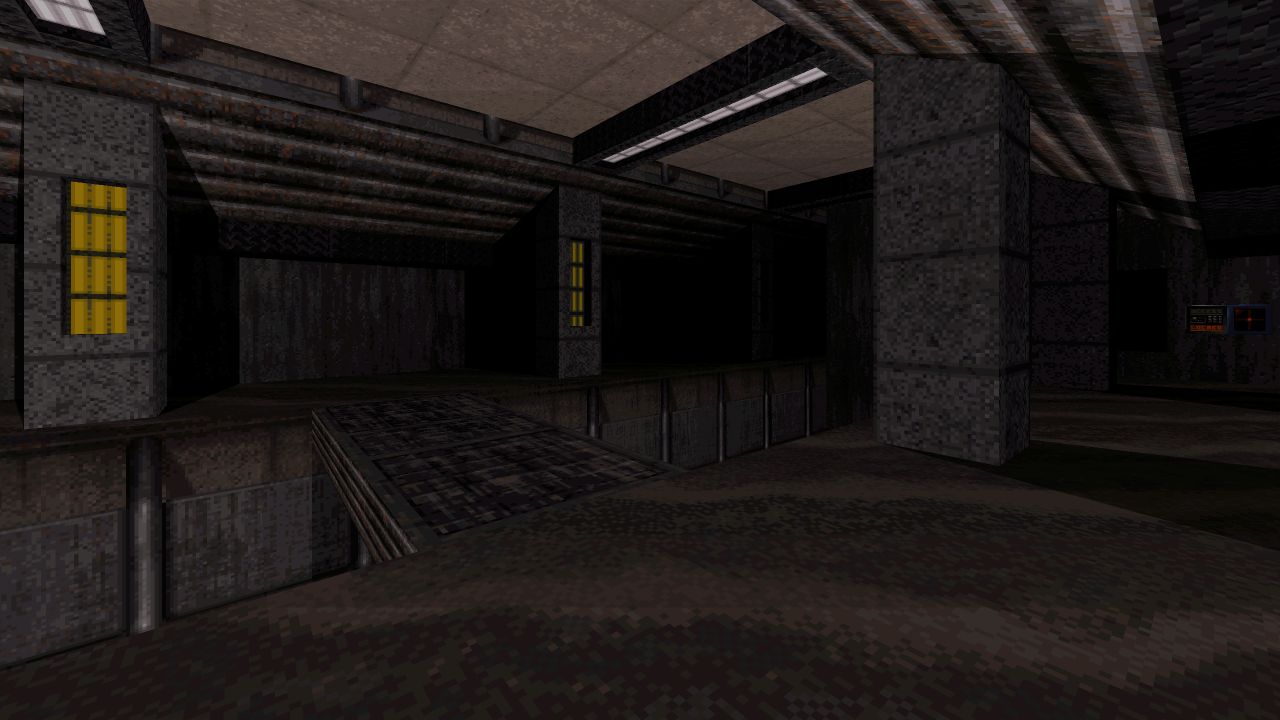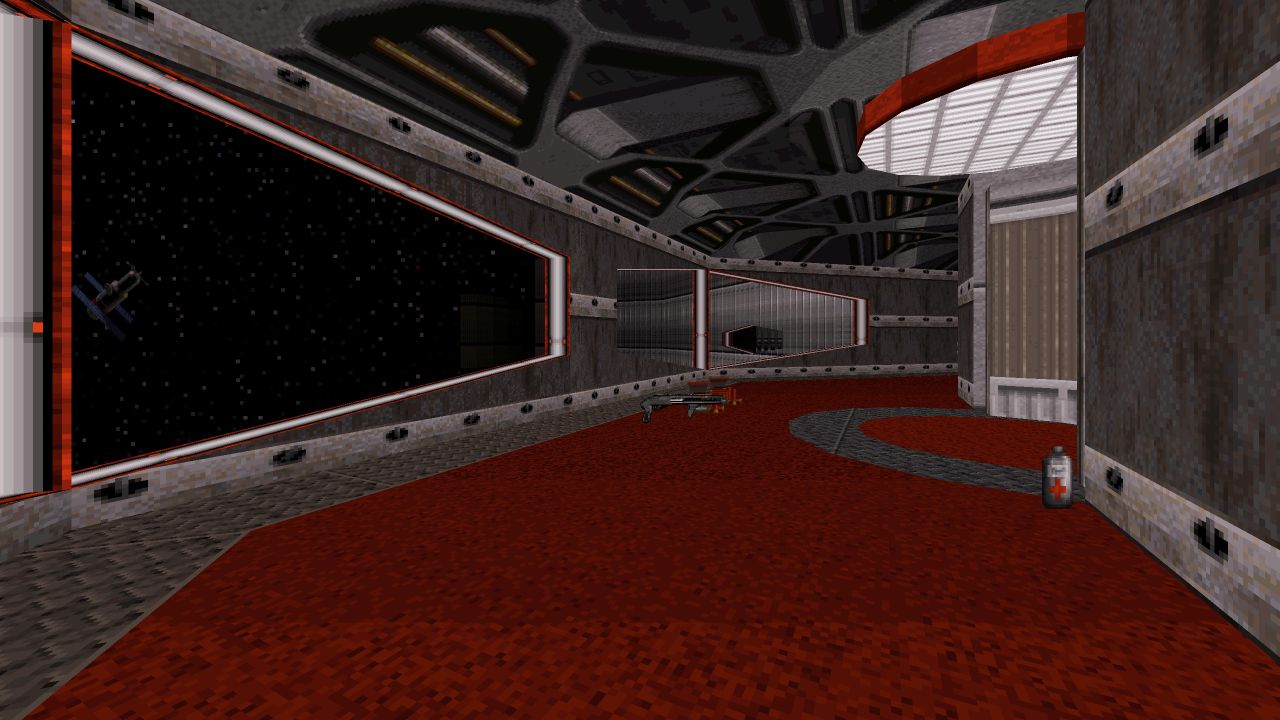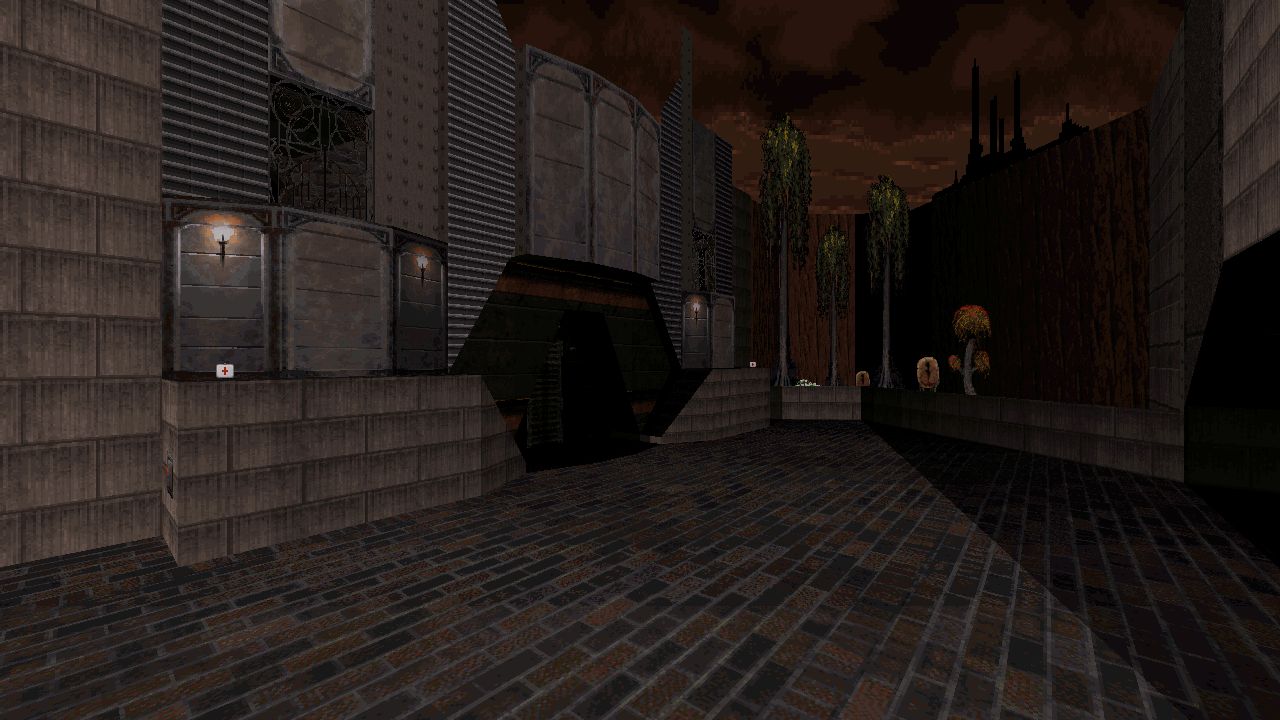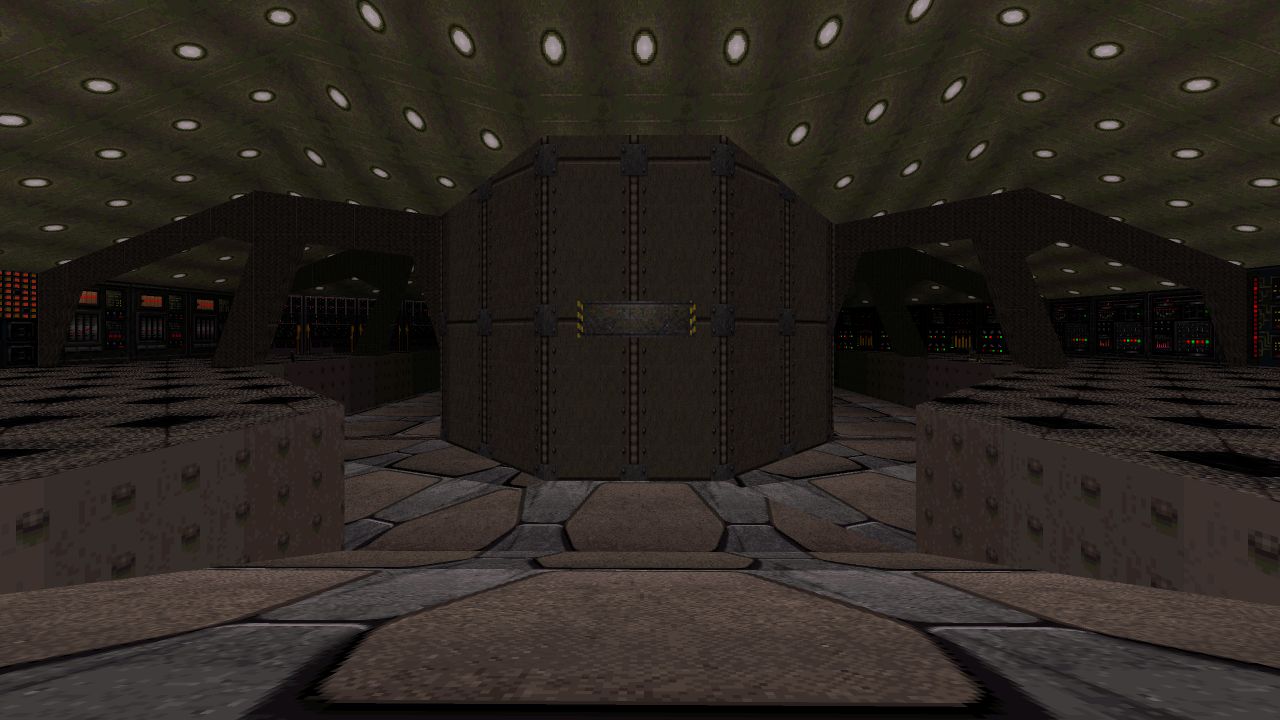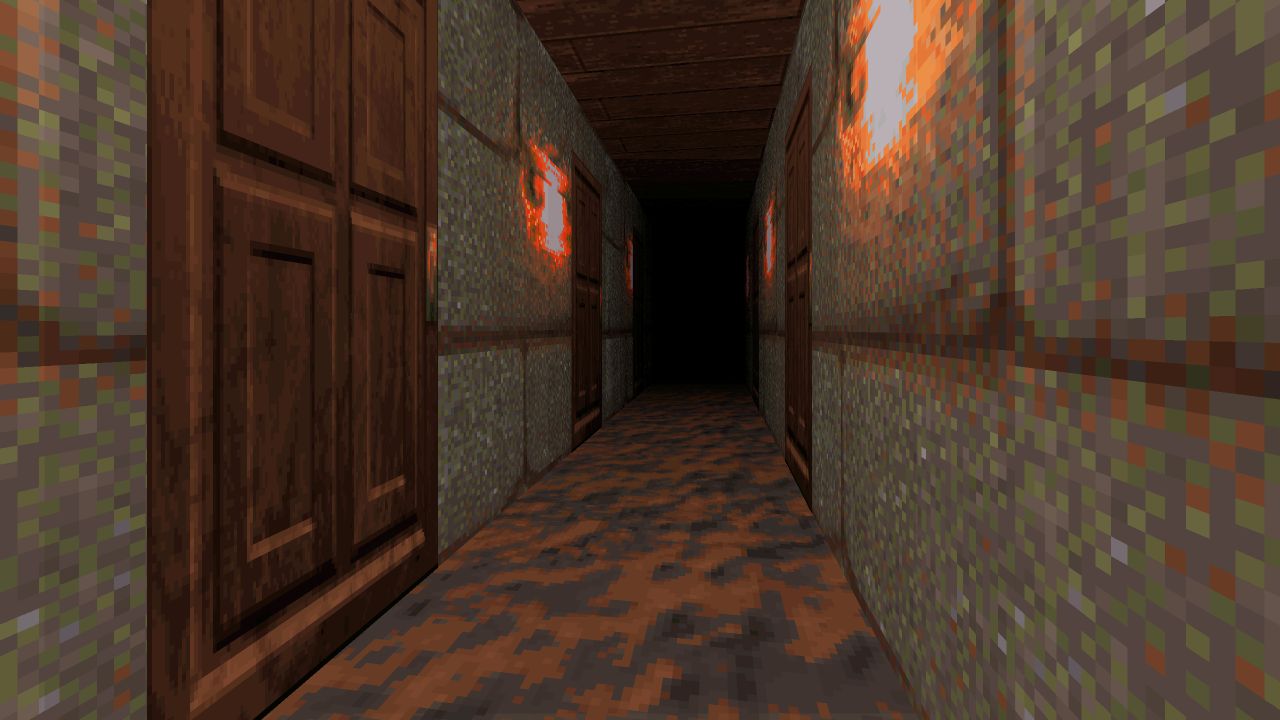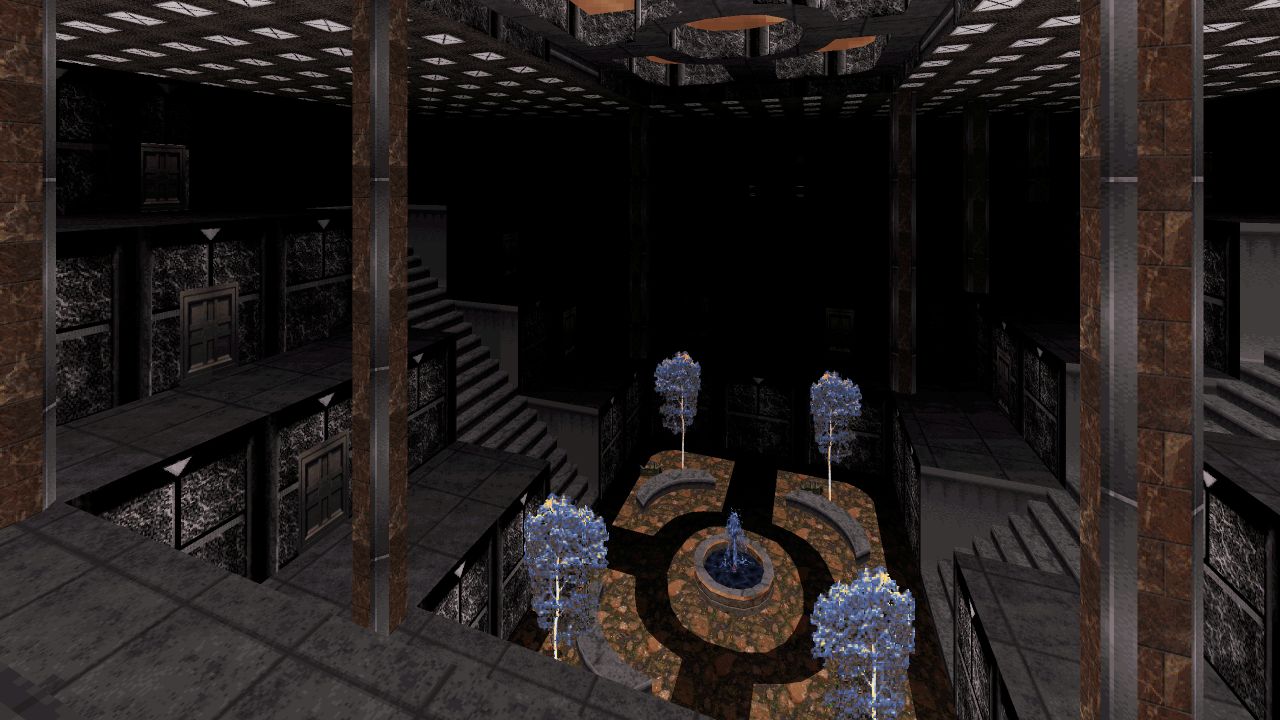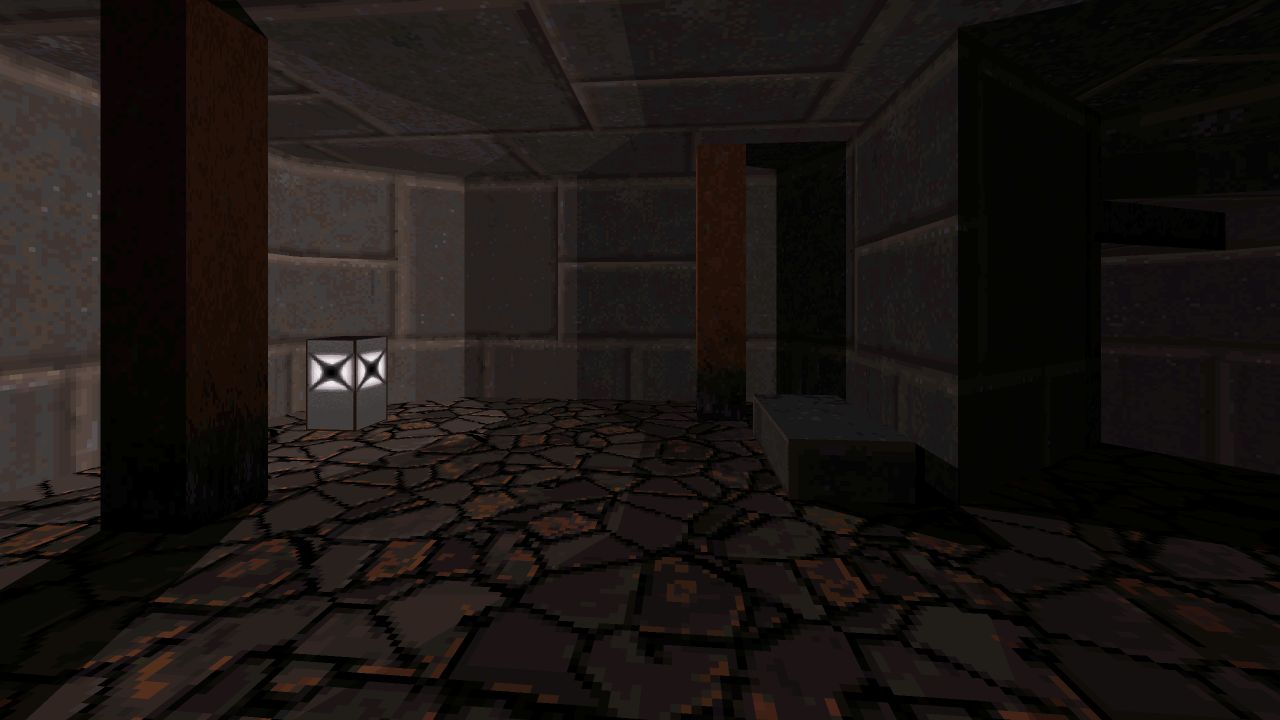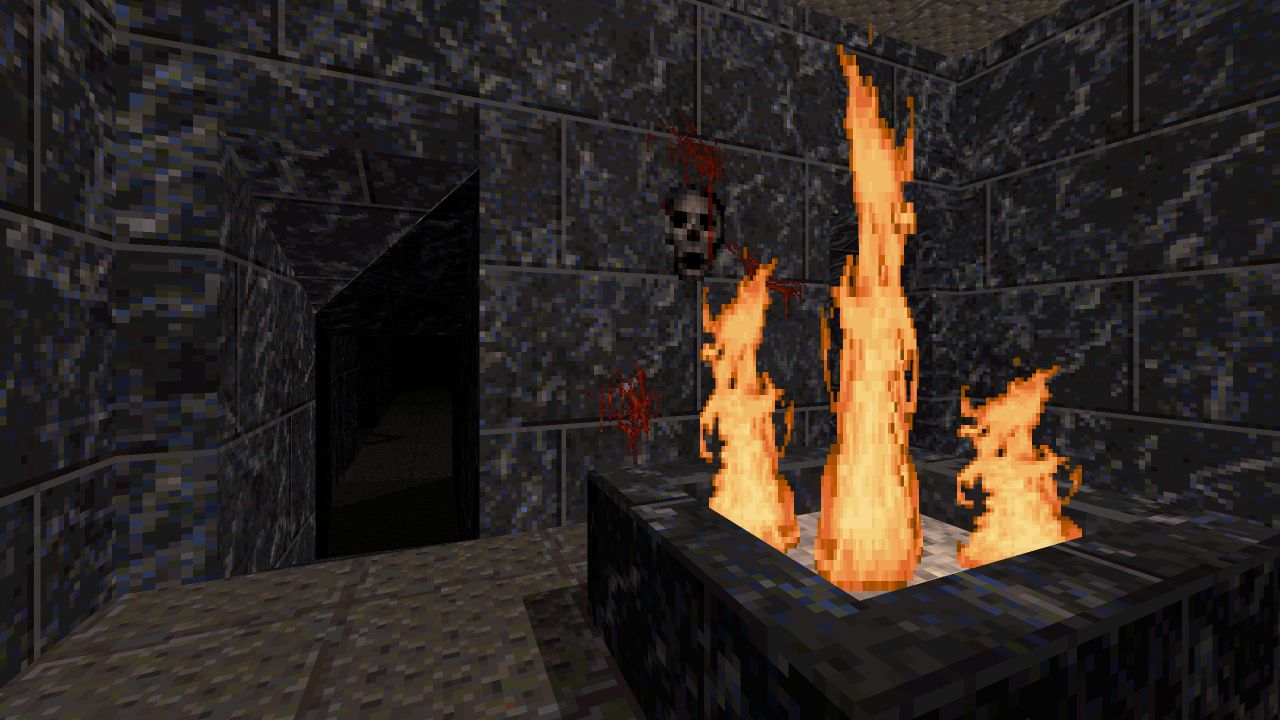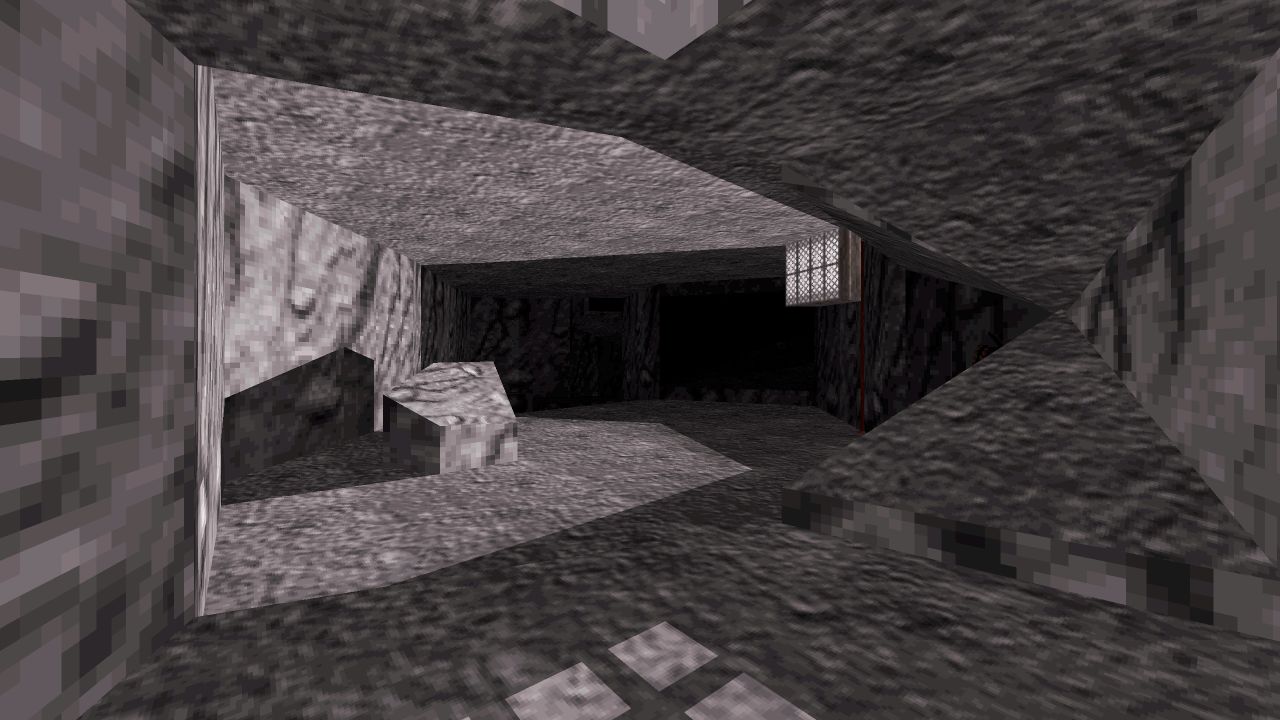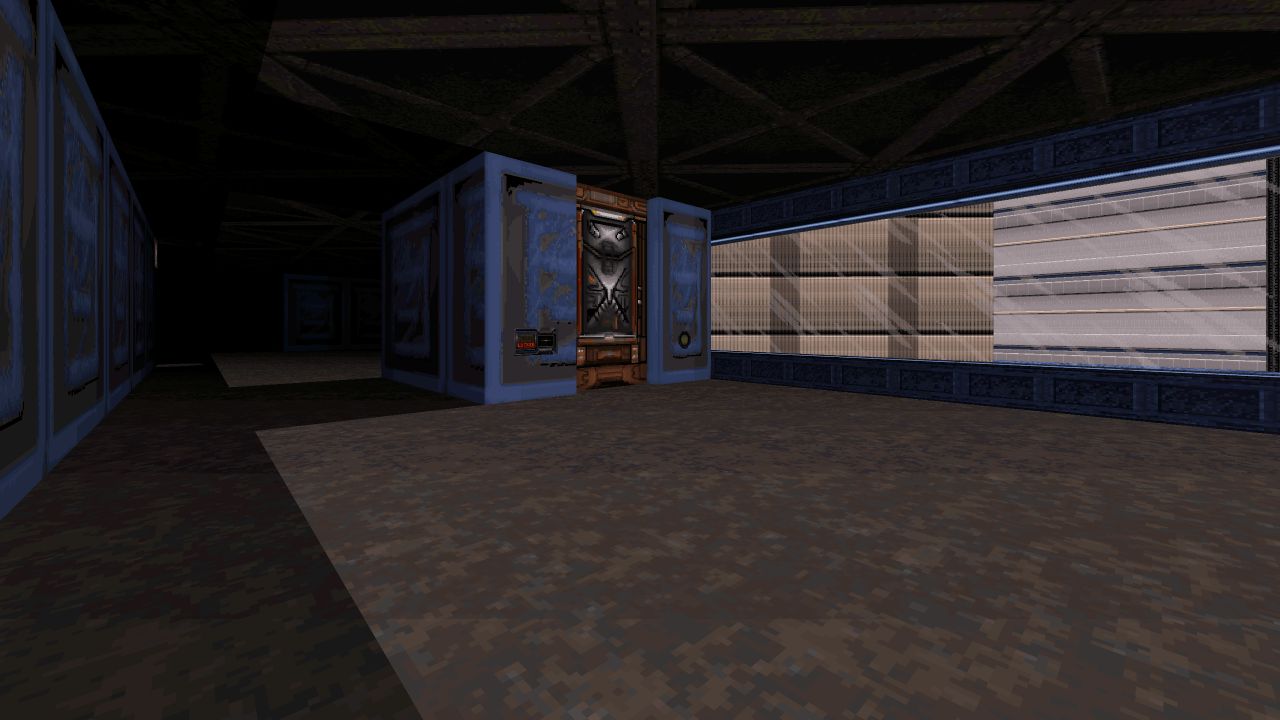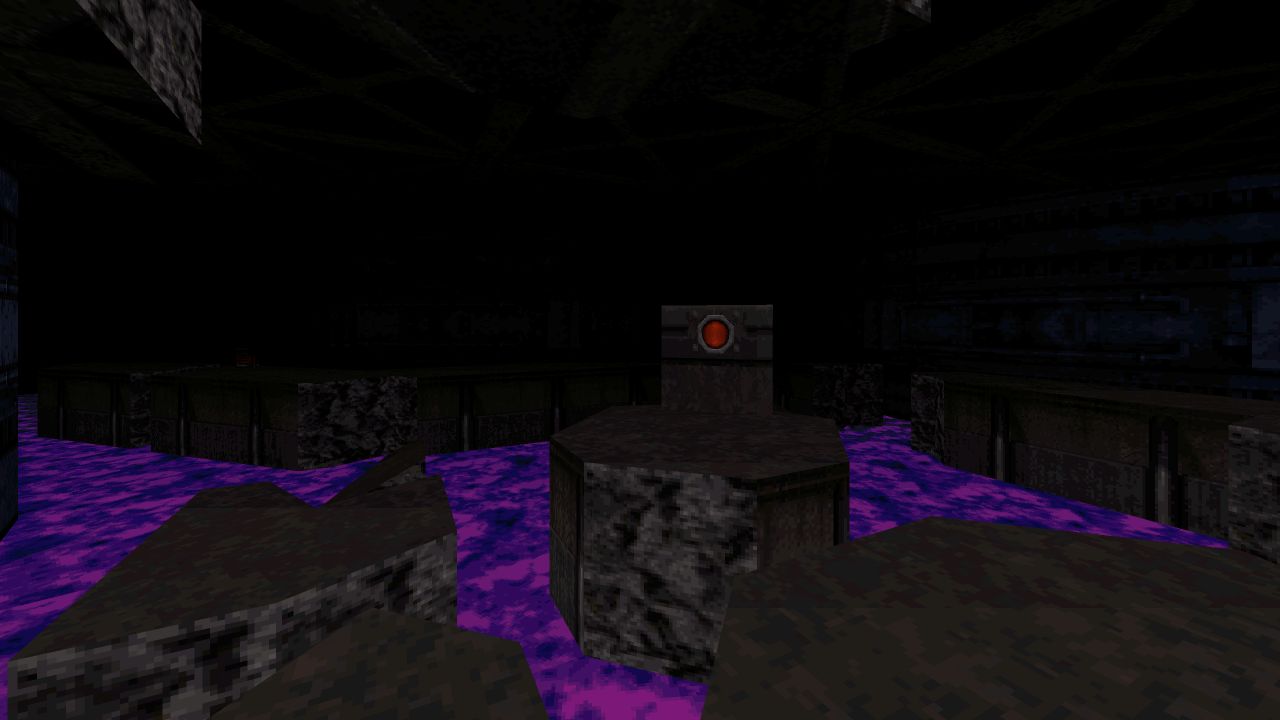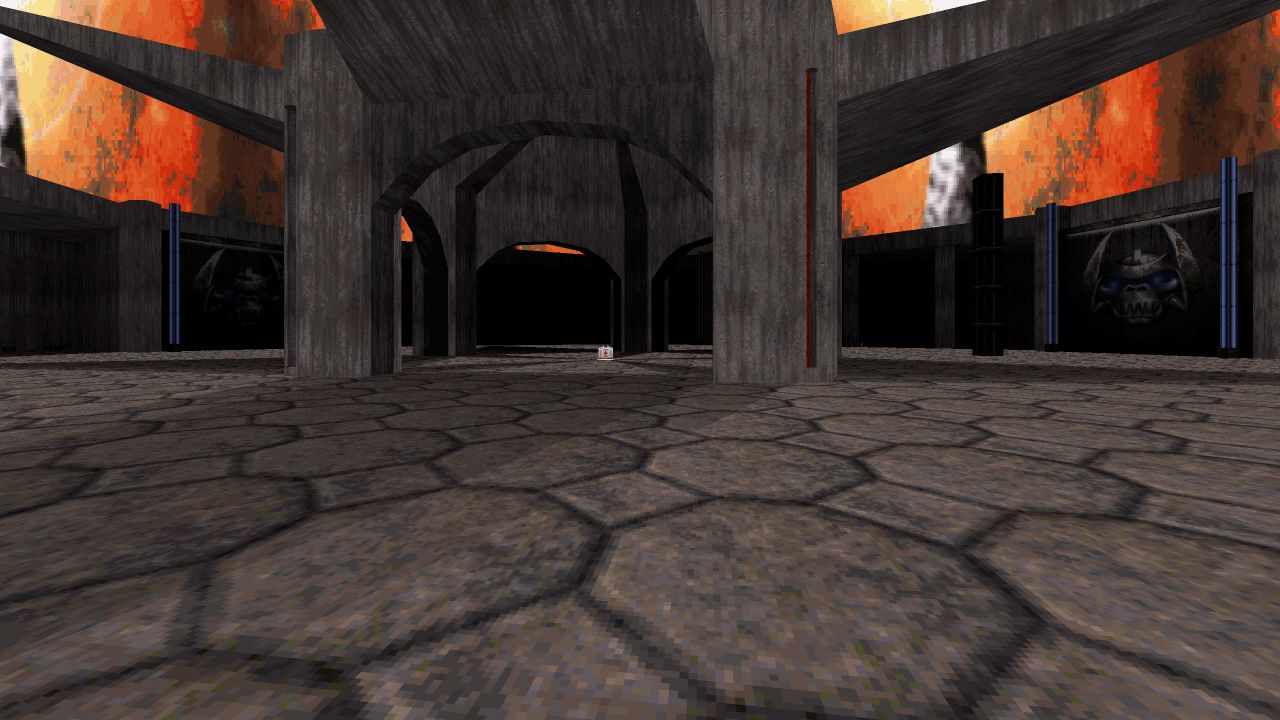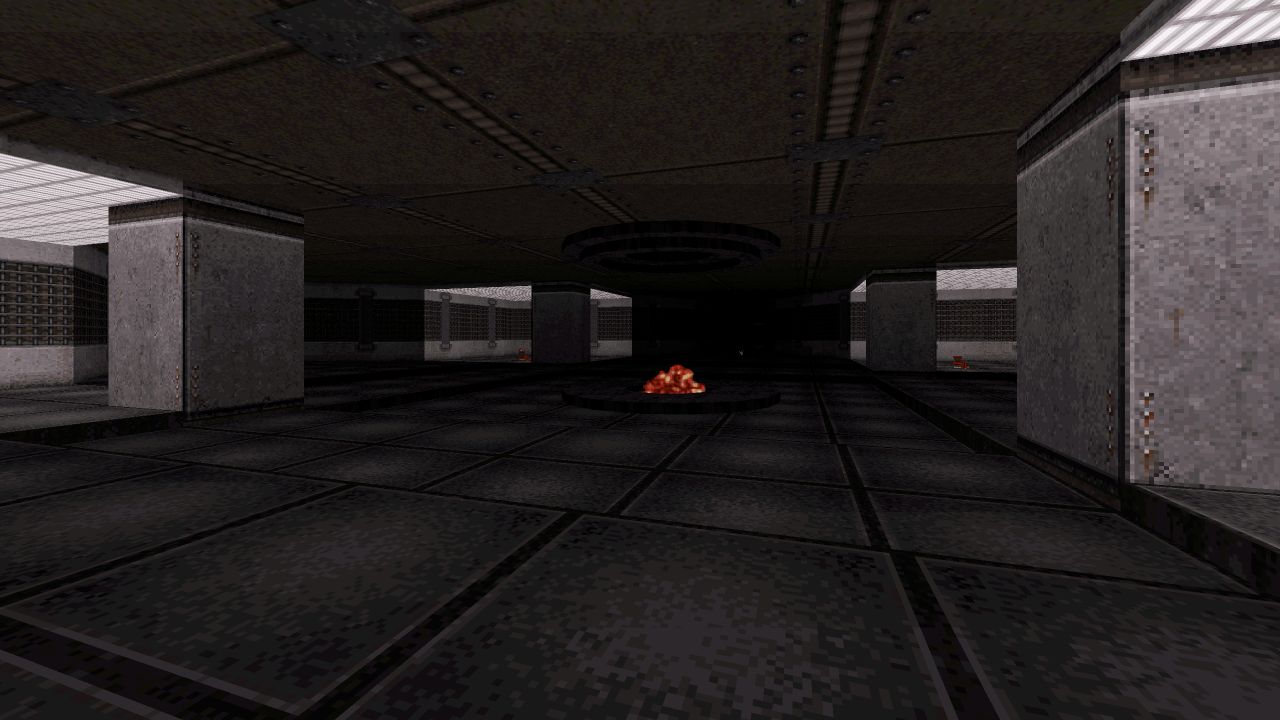Introduction
Duke must journey across his home planet Earth, leap on over to Mars and discover portals leading across the stars to the alien home world. From neon cities, old ruins, snow capped mountains to the red planet and alien bases, THE GATE is a 23 level campaign that seeks to take the battle against the alien threat back on their own turf.
Review
Tucked away in the README text file is both an elaborate back story regarding the alien race’s lore leading up to present day and an episode by episode summary of Duke’s journey and purpose for the level structure presented here. It’s deals with an ancient race trying to find a means of prolonging their existence, eventually leading to the creation of humanity itself amongst many worlds containing the children of Antirra and their plan to reclaim them. Duke defeats the invading alien forces which turns out to only be the first wave of a larger armada forming. Defeating the remnants scattered across Earth leads to the knowledge that these aliens are building a special gate that will directly warp them back to their home world; the Tanheuser Gate. This will obviously become a bigger problem if left unattended as it leaves Earth wide open to much larger threats, giving Duke no other choice but take the fight to them by defeating their council of Overlords while the EDF can mop up the rest.
THE GATE is quite lightweight with new additions on top of the base game. There’s a bunch of custom textures and decorative sprites to help define fresh level themes and elaborate on background details and locales for its story, or providing new art assets for a custom enemy and weapon. Most of these lack polish which results in several assets containing fullbright pixels and rough edges that can look unappealing or simply ruin how a scene should look despite getting the point across. Check these examples from E1L3 and E2L2.
One new weapon makes an appearance replacing the Freezethrower slot, called the CD-Thrower which doesn’t behave too much differently except instead of freezing an enemy solid ready to be kicked later, they’re shattered immediately upon reaching that state. This opens up more fire and forget situations without rushing into danger or swapping over to a pistol, leaving that risk and reward purpose solely for the Shrinker. There’s also some new faces amongst the existing roster. First is a floating robotic orb that slowly glides around making annoying sounds and exploding upon impact, more of a nuisance than anything but can act as a sentient explosive barrel. Similarly there’s the Organic slithering around, an odd snake like creature that’s hard to shoot properly, gets in the way and occasionally spits at the player but mostly harmless. The Scorpion Tank is an agile variant relying on hitscan weapons that remains dangerous at close ranges, better dealt with at a distance, a nice opposite to the usual Pigtank and cannot be triggered to self destruct. It’s only a shame these don’t find much use throughout the campaign in place of others. Another rarity are Blue armoured Troopers whose role is a bait and switch by transforming into a different enemy type. I didn’t witness this effect until around E3L5 because they’d be shot dead before ever performing their task, a fun idea but too slow to make any difference during combat.
Our main star of the show are called Predators, who’s behaviour and looks wouldn’t be too far out of place with their more iconic figures of the same name. These guys don’t mess around by acting like a wildcard with their many variations. They’re fast, love to dodge projectiles and disappear at random, like fighting against an unpredictable deathmatch Dukebot. Half the time I would wonder if they’re pre-firing just before I turn round corners or the moment I open up doors, adding a terrifying aspect to combat especially in terms of what firearms are available to them. Their choice of weapon is assigned per enemy and isn’t clear until they start shooting which might result in an unlucky close quarter shrink ray or shotgun blast. No visual differences have been implemented to help pick them apart from a quick glance either, so its typically safer to approach from a distance where possible before engaging. Most remain dangerous regardless if they’re wielding explosives or Expanders and are proficient enough to hit hard with them. I very much dislike having to deal with the Shotgun variants which can potentially degrade an experience when overused during a level. They can drop a player’s health from full to zero at a snap of the finger should they please and can take quite a beating, sometimes more than a few explosives. Attacking with a chaingun is just begging for trouble because they often retaliate between every stun phase and inciting several blasts in a row from their weapon of choice. I don’t mind their general existence but would have preferred a better distinction and dispered placement of these types.
THE GATE includes a 23 level campaign spread across four episodes, plus one secret level, each focusing on a major leg of the journey all around Earth, Mars and eventually warping to the alien home world, Antirra. Episode 1 is not the most impressive introduction for a number of reasons, which can be worrying with another three episodes yet to follow, but did manage to remain engaging across six levels for their charm alone. Progression and structure usually felt off by lacking coherency in terms of what should be going on. It doesn’t help either that many of the mappers involved rarely put key cards to good use, often placed in ways that pad out the current session for little reason rather than getting to the point. This signals many missed opportunities to better embrace and extend upon their chosen themes with meaningful additions for level progression, instead of halting momentum to track one key down just to acquire another moments upon using it. There’s also a major lack of polishing in many areas that makes the whole ordeal feel rough to play.
While Episode 2 still tackles some of these issues it otherwise takes a big leap forward as levels become more consistent by leaning into their depicted locales and themes rather than deriving into nonsense. It’s much clearer as to what we’re looking at and where players are expected to go moving forward which works well from a narrative point of view as the journey heightens upon arriving on Mars. It helps that these five levels were shorter, getting right to the point they intend to make and ending before losing steam entirely. The last two episodes take a greater focus on their more alien settings, with Episode 3 delving deeper into Mars and Episode 4 dealing with Antirra, by the time these get rolling I’ve already become immersed in this long adventure awaiting what other surprises happen to be in store for me.
Level quality can vary considerably, attributing credit to sixteen different mappers each offering a different degree of output. Paluski starts the adventure with a long, rough opening level that lacks a bit of focus. It does pair well with Heaths next level as a continuation even if too tightly packed. Wong & Barber are stand outs with stronger contributions that look good and flow well, with Mathews and Harris also offering some good ideas to their levels that change up the pace. Jury was mostly hit or miss for me, I didn’t mind their levels too much as they show potential if a bit on the messy side at times. Cacy does well to approach their unique settings but the unpolished custom textures harm otherwise solid concepts. Both Parde’s and Isenberg’s work didn’t grip me as their levels usually didn’t feel satisfying to play but there’s some good ideas within them. Forest’s levels were mean spirited with some very spiteful trap setups in a style typically not found elsewhere in the campaign.
Simon Castles and Jenna Ramsey are listed as music composers responsible for the custom soundtrack covering all the new levels that offers a variety of styles, sometimes with hints that remind me of the music from both Daggerfall and Star Wars. Most of these tracks lean toward upbeat rhythms or the sensation of a grand adventure unfolding, of particular I enjoy the midis for E1L1, E2L5 and E4L1. Others try to be more theme specific like E2L2’s chimes and drums grasping a cold mountain setting while players seek out an ancient monk temple. There’s otherwise moodier and darker tones embedded into the soundtrack that doesn’t quite hits the dreary lows of Duke3D’s Lunar Apocalypse soundscape, somehow instilling positive vibes or creating a lingering mystique surrounding this new looming threat. Of those, E3L3 really stands out with a sense of wonder despite the hostile nature of that level.
Conclusion
For an older campaign I’m quite surprised at how charming the whole package turned out to be, while draining at times it still kept my attention to see where things would eventually lead. I don’t hold any nostalgia for THE GATE having only played it this year for the first time, but there is a genuine sense of adventure taking place across the episodes. While there are varied levels and its clear we’ve been taking portals from one location to another, sometimes these starts seem abrupt and break any narrative flow that might have been building up. It can get confusing and seem random. Many levels also don’t hold up too well, the most common problem boils down to padding out length due to what seems to be a lack of ideas to fill those blank spaces with meaningful additions which could have benefited with more time to cook in the oven. Instead they will derive into pointless key fetching and hiding vital objectives in obscure places. Despite the rough edges I enjoyed my time with this adventure and don’t regret giving it a chance. See my break down below for more details from a level by level perspective.
Download Mirrors
Episode 1: They Live!
E1L1: LOS ANGELES by Shane Paluski
THE GATE starts off with a typical city theme very much inline with Duke3D before venturing off into other territory. It’s a large district covering several places of interest both high and low for supplies, while an upbeat and catchy music track feels right at home strolling down streets full of neon signs beckoning for our attention. E1L1 is a deceptively long level due to its open ended nature but a lot shorter considering the requirements for completion. The new Predator enemy makes their debut here without much build up, a prompt showcase whose presence adds unpredictability within the usual roster of familiar foes. From the hotel room there’s several directions players can begin their journey, so which one of these enemies is encountered will vary. There’s one using a Shrinker loitering inside a storage room that caught me off guard the first time.
LA is not the strongest opening to the campaign however, especially toward the end once we’re knee deep in sewage which wasn’t the most fulfilling place to be wading through. While there is an obviously dense urban skyline, its sparse design at this scale holds it back without good lighting to break up the darkness, too monotone to suggest a night life vibe and could have created appealing contrast up without the need to go overboard with details. There’s a fair amount of aesthetic and ambient quirks strewn about creating this out of ordinary vibe most 90s user maps tend to have which I can have a soft spot for. There was this deranged laughter on loop coming from an ambiguous source up in the East Town Towers, even the sewer ambient sounds didn’t feel natural either as if something unknown skitters amongst the echoes. These areas don’t always hit the mark however and soon come across as these random, arbitrary places to fill out spaces. Progress will eventually lead into some white caverns, a secret hallway and then some chamber I’m not too certain is supposed to represent but exists to home a duo Battlelord encounter. Beyond that appears to be a lab with some nearby toilets and a hive section almost copied right out of the end to Lunar Apocalypse. Cohesiveness was lacking here which might have benefited by trimming all this away considering the next level tackles similar ideas more consistently.
E1L2: UNDERCITY RESEARCH FACILITY by Jeff Heath
Initially I was worried that we’d be seeing more of the sewage theme going forward but sighed in relief once it switches gears into an underground shopping arcade, a good opportunity to chill out and have fun checking out the different stores including a unique Egyptian themed theatre unlike the usual Hollywood Holocaust templates. Hidden beyond this facade is another hidden laboratory, an entire section dedicated to one location for research and experimentation from cloning, modification and terraforming. I feel this level becomes a nuisance to play after the yellow key card reader. Keycards are hidden in arbitrary caves and there’s many enemies forced into small spaces just to pad out the length without reason. The intended progression toward the end to disable a forcefield wasn’t too clear either, there’s a switch behind an unmarked door using the same texture for other non-interactive panels that didn’t seem of importance. The only sign something might be amiss is a subtle flickering light that seems suitable for a secret place, an obvious door or shutter texture choice might not have halted my steps figuring out what was missing. The whole process felt a bit of a mess something tells me everything is packed a little too tightly and becomes super noisy once around the labs, with constant lightning strikes zapping away. There’s a promising level underneath it all and I liked the concept of those artificial environments from terraforming tests, I just wish this level could breath properly with better indication what is intended from the player and an expansion on its solid ideas.
E1L3: AZTECH by Nick Parde
Taking a drastic shift away from urban streets and underground laboratories, stepping into the portal warps Duke to the steaming jungles of South America, a linear level focusing around delving into old ruins occupied by an alien presence. Taking a dip into a river has players beaming down the ravine because of a strong current leading them to a small scale pyramid made up of large green bricks. AZTECH’s title suggests a blend of an Aztec and Technology theming making those aspects known with a shrink ray puzzle sequence and subsequent inner base sections. The initial goal is to become small to squeeze a way forward to pull a switch and escape back out beyond a blockade, to then avoiding being shrunken during a jumping section to nab a red key, a fun little combination to mix up a familiar scenario. After that however I didn’t enjoy much else of the level, especially as the visual side looked rough. There’s an unsubstantial throne room with barely much inside beside poor looking stone walls, left to wander toward an empty opposite side for a wall to explode revealing a way to continue forward. Combat would often find myself at low health during long stretches pitted up against various hitscan gunners, Sentry Turrets and Drones or an occasional Predator around the next corner. All that encouraged was creeping forward at a snails pace just to stay alive. Except sometimes even that isn’t enough like during the final river ride, zipping around a corner to find a lonesome Drone positioned so conveniently to explode in my face. As a whole it’s an underwhelming experience that starts off promising but loses its appeal once the seams in gameplay show and design quality drops off.
E1L4: YUKON DUKE by Tyler Matthews
I became allured to the visual style from the moment we warp onto the field, a daytime setting within a rocky ravine, strong shadows for contrast and a natural terrain that sets itself apart from canyons that typically plague Duke3D levels. There’s not much choice for creating these environments yet Matthews still pulls this off using vanilla textures while custom trees help to embellish the scenery. Two distinct paths were a nice addition, travelling down river is a quick but dangerous route while an upper path takes a detour inside a cabin built into the cliff side, a cosy little wooden bunker retreat that provides cover and some supplies to grab along the way. It’s then a shame the latter route is required to find a blue key card. The only missing ingredient is more ambient sounds like wind or wildlife to make the stroll less quiet.
There were some diminishing aspects affecting my overall enjoyment. Shotgun only variants of the Predators are used far too often for my tastes that cause unfair deaths and destroys the pacing for fighting because of their large health pools. Types using lasers or rockets could have worked well across these long ranges. There’s also an odd decision in regards to progression and two keys in general that have no added benefits besides backtracking to locate them; the blue card can be found before the lock itself and a red card is buried behind rock for no particular reason. These two coloured locks are required one after the other with a mine cart ride in-between them. One could have been enough to get the point across considering how they don’t expand much upon existing areas, a missed opportunity to involve a proper mine section where players dig deeper to locate said key.
E1L5: ANTARCTICA by Paul “Talon” Jury
I enjoyed this one for the most part for the simple fun of exploring a well realised base with all the quarters that you could expect for such a place. Inside one of the bedrooms is a nice attention to detail with a stuck closet door and note pinned up beside it. I assumed this to be a bugged out door that was later turned into a feature since a little force eventually pries it wide open. There are some rough patches like unkept texturing work and tight spaces making navigation a nuisance at times, but there’s otherwise a solid foundation here despite some poor execution and attempts at padding out length. The underwater sections are especially a sore spot encountered early on that don’t offer anything of significance while swimming. Upon first diving there are two long, empty tunnels only existing to connect one place to another along a specific distance. This becomes double time wasted if the wrong path is taken first, albeit containing a nice view of the submarine end goal but ultimately a dead-end forcing players to backtrack. Taking the correct path involves a long process moving through boring spaces until reaching the main base. Here’s a map view to showcase what I’m referring to. Jury at least had the heart to include a device underwater that refills the airtank when operated. Another missed opportunity here for a more involved underwater segment following the Antarctic theme. Underwater caves, frozen bodies of water, gaps to resurface and venues to explore only accessible via this method of traversal until shortcuts can be unlocked or blown open. There’s already a working template for this during the portions on foot that can be extended to include aquatic gameplay and provide a little variety for progression.
E1L6: SUBARCTICA by Paul “Talon” Jury
Jury’s second output is unfortunately their weaker entry that also concludes the first episode that left me with an ongoing concern for the remaining three episodes from this point forward. SUBARCTICA has players discover a strange gateway that transports them to an ancient place, described in the text file as a dimensional nexus of the Antirran Foreward Observation Post, a theme suggesting classic Egyptian and alien connections but doesn’t quite capitalise on its full potential. It’s a rough level that relies too much on maze-like button hunts down randomly shaped brick hallways and insignificant offshoots that add nothing to the journey as if biding time. There’s a lack of polish with poor texturing and missing art tiles, possibly accidental removals during THE GATE’s release compilation. E1L6 comes across as a basic draft during its first pass. This all culminates toward a disappointing end battle considering how simplistic and safe it tries to be, an incredibly easy bout against a single Battlelord because of a forcefield surrounding the central pyramid nullifying all incoming attacks. Jury has already revealed that they’re capable at working with the editor and showing off decent results from their previous entry and there’s moments of good design here by showing off nice lighting in the maze and a luxurious portion beyond a portal that could have served as broad strokes for a much better level if given more time to consider concepts.
Episode 2: Tourist Trap
E2L1: BERMUDA TRIANGLE by Tyler Matthews & Paul “Talon” Jury
The second episode starts off strong with a more memorable and consistent opening level because it focuses around one specific theme and locale that also re-orientates players back into a sense of normality before hitting them with that underground portal leading to Duke’s next destination. A sunny hotel along the coastline somewhere close to the Bermuda Triangle, the aesthetics reminds me a lot of Duke Caribbean’s first level. Additional places for flavour include a lighthouse, some boats docked at a harbour and small residences along the cliff side. It’s an enjoyable session without too many annoyances to drag it down like earlier levels, Predator usage is tame and doesn’t rely dominantly on shotgunners, however some key requirements seemed mostly pointless. In this current scenario the blue key is only needed so that a red key can be acquired, the latter then used to unlock a door where the yellow card reader is located. These could have been trimmed down to only a single lock for snappier pacing, while every other location serves to build up supplies for the upcoming levels.
E2L2: HIMALAYAN HELL by Jonathan “Lizard King” Cacy
I honestly got worried early on that this was going to become a trial and error test of patience type of ordeal and already had alarm bells going off, what with the non-solid floors to progress and those instant drop off cliff edges causing a quick plunge to the depths. Thankfully it was much simpler to progress in execution as taking a leisurely pace to let each quake play out doesn’t result in punishment. The airplane crash is a nice touch to break up the scenery and enjoyed the inclusion of “tests” given to players, having a good guess what they were going for here and it soon makes a lot of sense afterwards. The second half holds a more traditional section with keycard hunting, but takes place within a hidden monks temple, a theme that isn’t given the time or space to reach its full potential and is over soon after arriving here.
Turns out HIMALAYAN HELL is an updated variant of Cacy’s standalone release of the same name, this time taking advantage of custom textures to give the temple a unique style, while gameplay doesn’t stray too far from what it established between versions. Compare the original with this version. But this is where the lack of polished textures does a disservice for the level’s aesthetics even if the conceptual side is solid. One change I dislike is that one of the keys is hidden behind a fake wall, only discovering it by accident to see if there were any secrets, while the original hid a button in plain sight and the wall opened revealing a niche instead. The new art choices do fulfil their role and scenery looks nice as a whole, reminding me a little of ancient places found in the classic Tomb Raider games, but they could have done well by cleaning up the blemishes and rough patches. There’s a section within the dark caverns that reveals some egregious textures dotted with fullbright pixels causing more harm than good.
E2L3: LOWER PLANES by Ryan Isenberg
One of the stranger level starting points, a dark underground volcanic hotspot that seems to be a natural cavern soon clues in there’s more than meets the eye here. Besides aliens occupying the space for seemingly no reason, there’s even a spotlight setup complete with wiring as if trying to draw attention to itself. Dropping down into the volcano’s gaping maw reveals another portion of the caves that have been converted into some kind of facility. Of course being the only entrance hidden in plain sight turns out to be rigged with surprise ambushes, elevated shooting positions and bunkers ready to finish any intruders as their first line of defence. Forcefields blocking paths serve has a secondary line and, should even that fail, a larger force of Predators become prominent opponents guarding the exit portal. On an initial impression it seemed a more involved level because of these earlier moments to overcome their tight security, but turns out it’s a more simplistic level overall at it’s detriment once access beyond the trapped portion is attained. There’s a solid concept here but Isenberg relies too much on symmetrical design and layout here without any variation when exploring deeper into places only seen, all while the ending portal lingers within reach ready for players to move on at a moments notice and this becomes a reoccurring pattern in their next contribution.
E2L4: FINAL ENTRY by Tyler Matthews
This time we’re hitting a launch base for rocket departures going to a Mars colony, which will be further explored upon during the proceeding level, but for now Duke must first secure his flight into space. I do enjoy it when THE GATE sticks with a singular location because these tend to be focused and consistent, FINAL ENTRY being no exception and a good narrative lead where this adventure is heading to for its third episode. There’s not a lot to it with a few places for simplistic key and switch hunts that open up barriers leading to our goal. It’s a shame there wasn’t a more involved section beyond the blue card access, expanding upon maintenance and engineering areas that would typically be out of sight, which then loop back onto the other side of a secondary barrier. Instead there’s a switch for it seconds after descending an elevator. The ending sequence as the rocket launches into space is a nice touch however, being provided a view of the stars zooming by after breaking beyond the atmosphere. Too bad the sky scrolling effect is bugged in both Rednukem and Eduke32 so the effect can be lost playing with those, but works perfectly fine via DOS/DOSBOX.
E2L5: WELCOME MAT by Paul “Talon” Jury
While the general course of progression doesn’t deter too much from other levels, this is probably Jury’s best contribution for THE GATE that I enjoyed spending time with. It’s like an improvement over the structure from his ANTARCTICA level, still rough around the edges but retains a good sense of location where both public and maintenance sectors are traversed. Those broad strokes to depict a Mars landing port have been pretty successful from a design angle starting with its security checking process before anyone is allowed to step foot into the station. That then leads into a semi circular observation deck overlooking the Mars surface with seating arrangements for watching incoming shuttles while waiting for trams to arrive, a sight that stands out. A central hologram showing the planet and its satellites rotation and the deep red outdoors creates a convincing off planet feeling, the only thing that feels missing here is a kitchen for ordering food and drink during this downtime. I especially liked the aesthetics of the living quarters, each a unique little space with tan or blue carpets adding to their a cosiness. There’s something about the whole theme and its stylistic choices here that showcases Jury’s work does have a lot of promise in them but don’t quite stick the landing when it matters. Both of his episode conclusions end on an easy and redundant boss fights, I’d have much preferred them to involve a simpler conclusion for the next episode to carry on with. I did get lost relocating the red key door at one point but uncertain if that’s on me because I couldn’t recall its placement or with it being tucked away at an earlier indistinctive portion that was easy to forget about.
Episode 3: Red Planet Blues
E3L1: HOSPITALity by Demian “Wolfgang” Holmberg & Preston “Sluggboy” Packard
Duke finds himself digging deeper into the planet via a network of caves where streams of lava flow. An early jetpack is provided to ascend a vertical chute within these tunnels but there isn’t much verticality beyond this point, most of the level remains within approachable limits while on foot through additional caverns and an alien bunker. This is an odd level to start the episode with primarily due to a relatively simple concept that lacks clarity for progression and doesn’t have much to say in regard to gameplay or narrative. Important paths forward will be blockaded by walls that require explosives to blast through, none of which are found along the normal routes. Instead there’s an expectation from players to dip into harmful lava and consider squeezing through these small gaps to discover what is required. It wasn’t the most obvious approach as the gaps seem far too tight at a glance and seem better suited for hiding a secret.
E3L2: Martian Red Light District by Jonathan “Lizard King” Cacy
This is the seedy underbelly of the planet, an alien urban district where all the locales are drenched in sexual overtones ranging from strip clubs, erotic bookstores and so on. There’s an over abundance of red hues to loudly proclaim its red light status, split across two portions with a subway running between them. Most of these places are optional exploration detours while the main route is restricted to a few specific buildings. Hunting down the keys did involve some problems during my initial run, having found a red card and nowhere to utilise it. After some thorough combing around I missed an unsuspecting hiding spot with a blue key I otherwise had knowledge where to use, which in turn eventually lead to the next access panel. If rushing to the ending isn’t a priority there’s a lot to engage with here. Combat is fast paced, enemies are frequent and the Scorpion Tank makes its entrance here. There’s some unique effects at the end with a door collapsing into itself and Duke being dragged out onto the Martian surface. Too bad I missed the Total Recall references having been a long while since watching that film, but this level gives me a good excuse to rewatch it down the road probably along side other Verhoeven classics.
E3L3: Ancients: Halls of Man by Matthew “MattCake” Harris
Welcome to a level that wouldn’t feel out of place in DOOM, an ancient dungeon that appears more demonic in origin than alien. E3L3 takes a moment to break up the usual formula and pit players against a hostile and rigged environment, those aliens who reside here only become but a mere nuisance compared to the omnipresent ire that permeates this realm. Built with large brick and stone, surrounded by scathing pools of lava, ANCIENTS does not appear like many other levels in THE GATE. It almost seems as if we’ve been whisked away to hell due to an improper portal destination, but otherwise I like to see it as a gatehouse of sorts to scare off potential invaders before they push any deeper into the base that resides here. There’s some nice ideas at convincing this hostility, explosions being directed specifically towards a players probable position or when lava rushes down a hallway with no means for escape. I also enjoyed finding hiding spots with extra goodies, looking out for walls to crack open or using monitors to discover any tucked away niches.
E3L4: DNA Strand by Cho-Yan Wong
It seems we’re not quite done with exploring ancient places just yet, only this time the mood shifts to feel calmer and mystical, a more classical dungeon environment adorned with marble constructs and fancy ornamentations. Wong’s style is unlike most levels up until this point using rich and varied texture schemes with some excellent lighting setups so that there’s a specific identity for different sections, all while the visuals grasp a good sense of polish across the board. There’s a certain strange ambient about this place that evokes a bygone era where both Duke and the Aliens seem out of place. DNA flows well for a non-linear level that involves seeking out three keys to unlock the exit. Exploring these old halls will find that they weave in and out, looping back round where other portions are visible through windows or pillars. Taking a peek may reveal a shootable switch or an entrance that can only be opened from the opposite side. This ensures all routes are vital but expects players to decide which one they should commit to first, potentially coming across access cards before finding out what they’re even required for. Switches also utilises convenient markings to pinpoint what door these target making these searches less of a pain. Along the way effort is made to force players into tailored combat encounters like having to drop down into a one way pit to face off Protectors at the only way out, or having a close quarter fight against a mortar wielding Predator within a small space which caused me more trouble than I’d like to admit.
E3L5: Star Chamber by Cho-Yan Wong
From dungeon to space station, Wong’s second level doesn’t differ too much from their previous entry besides the theme, approaching a similar progression flow while creating more points of interconnectivity. It doesn’t really surprise me that their roots come from creating deathmatch levels because this one in particular isn’t far off, where there is little need to backtrack when one portion will eventually route back round to an access panel with additional shortcuts unlocked along the way. The blue key is entirely pointless though only serving to store a yellow card. It’s more of the same but lacks something that ties the experience together, there’s a good amount of combat and secret hunting to make up for it, but isn’t quite as memorable acting as a transition into the next level.
E3L6: Tanheuser Gate by Aaron Barber
Episode finales haven’t been too successful at being engaging ends to those particular journeys up until now, so I’m thankful that Barber’s contribution here breaks that pattern and follows through as a great send off into the upcoming episode. The titular Tanheuser Gate resides here, inside a large ominous dark cube just floating out there in space and Duke aims to get inside. This involves a linear progression of key card hunts granting access to various parts of the space station and from there devices can be used to remove seals from the massive structure, a chilling scene as it morphs open while retaining its cubic form. Limitations really work to its favour here, presenting an alien nature to this technology in the simplest of ways. The level itself is still rough at times with several questionable choices as a means for progressing forward which isn’t always clear cut and involve some odd triggers required to move forward. Switches inside the bathroom or behind secret panels for example don’t jump out as an obvious place to unlock vital doors. The entire process to get inside the skylab gave me some trouble too. First the doors are unlocked by stepping onto a touch plate besides the monitor, which likely causes more problems during replays if I were to ignore it already knowing where the camera points to. Even upon arriving at the skylabs entrance I saw a forcefield surrounding the teleporter yet to be disabled, later discovering it was just a visual illusion and the front side wasn’t covered. Barber does have some good ideas even if their execution can be disjointed and unpolished overall. Facing off against multiple Queens and a mini Cycloid before the finish line is a potential favourite of mine, a bit more memorable than previous boss attempts even if they all eventually get stuck inside the lower pit.
Episode 4: Takin’ Em Down
E4L1: Wilderness Receiver Facility by Aaron Barber
After stepping foot into the Tanheuser Gate, Duke is spat out from a wormhole into a canyon on some alien planet, a ravine with toxic river cutting through the middle and strange looking trees. In fact we’ve seen a scene similar to this one before including the same type of trees, back on Earth where they were experimenting with terraforming. This is a nice callback to E1L2 where it further elaborates on efforts to recreate the environment of their home world and not just any bog standard climate. The droning wind here feels isolating despite the enemy presence, even as I delve deeper hearing these odd whale cries underwater luring me toward a cavern and those eerie cave echoes emphasises just how far from home we’ve come. It’s not an immediately hostile presence either, almost calming as if the planet itself doesn’t have any ill intentions, only those whom inhabit it. After gaining access into the alien base sections, design gets a little more experimental and puts more emphasis on those late 90’s era aesthetics. There’s a large control room late in progression housing an angled ceiling and unique pillar struts holding the place together which stood out to me for its bold and unconventional appearance. I really found a lot of enjoyment crawling around the many floors of the base, with all the moving parts like an automated conveyor system, taking a tram or draining the toxic river into otherwise inaccessible sections. It felt as if I were infiltrating somewhere I didn’t belong especially when a ceiling opens up from absolutely nothing leading to a giant antenna or stepping into a small maze that exists only to delude any unwanted guests.
E4L2: Into The City by Crista Forest
Having breached the initial defences and taking the fight underground, Duke finds himself reaching a network of caves and halls representing an Antirran city. Old places of civilisation have been a common theme across THE GATE, but none have been quite as spiteful as this one. Forest’s contribution is a mean spirited dungeon crawl that’s rigged from the start and can get a little frustrating how it pulls the rug from under you. It’s like sitting at a table top session with a game master, except Forest’s sole purpose is focused around wiping out the party as a self presented condition for winning. There’s an entire maze section partway that practically follows this definition, involving many dead ends and a ton of gotcha moments that don’t lead to any progression. Sudden tripwire explosions, crushing ceilings or one way cage traps. Some of them were admittedly funny but otherwise minor setbacks when a quick reload is all it takes to continue onward. Some of this dungeon crawl design shows itself a little earlier with four cell blocks housing Predators, where careful perception plays a vital role to solving what’s going on here. I’m on the fence how I feel about Forest’s particular mapping quirks, for one they’re refreshing and forces some careful progression, while on the other hand THE GATE hasn’t necessarily involved these aspects to gameplay with this much hostility besides E3L3. On a positive note I did like how the actual urban hub appears with these tiny chambers stacked on top of another with nothing but a bed and closet to their name, while a massive throne room is a short walk outside from here. It paints a dire lack of individuality for their race, simply numbers thrown into the slaughter to get one job done and nothing more.
E4L3: Secured Pleasures by Nick Parde
Based on how the previous level had a particular fierceness toward players exploring its halls and doing everything it could to hurt them, Parde’s work performs as a suitable direct sequel to that notion by continuing on with a prison block serving as a dungeon gauntlet. Cells are one of the earliest details to come across that quickly gives away what purpose this place serves while all doors leading out are typically shut tight with combination locks. There isn’t much button hunting due to the small scale of each section, but many of them do exist as if persuading escapees away from pressing onward. Pulling one switch usually isn’t enough to open up a path, simply unlocking another room with another switch, which too unlocks another room with another switch. Sometimes these rooms are trapped and sometimes they’re not. Normally I would be against this repetitious pattern and reliance on switches as a crutch to pad out the length, but here there’s purposeful intent behind the action from a narrative perspective, as if the owner of this dungeon is relishing in their victims dread when they eventually give up with no end to the switch puzzles in sight. Even should these blockades be conquered, an Overlord waits up ahead to finish the job right before an exit as one final taunt, only now do I understand what the level name might be refering to.
E4L4: The Hive by Ryan Isenberg
Despite having to contest with deja vu, not realising until later that I have indeed played the standalone release of this level several years ago, it still remains an oddity of a level considering how short the experience really is. Both keys are still required but a massive chunk of the level is optional, filled with many detours and destructible walls, the enjoyment comes from seeing where the base eventually connects by seeking out these shortcuts. Otherwise as long as the blue key has been used, the exit route is immediately available from the central pool room and the intended blue route can potentially be ignored without receiving much retaliation in response, except the doors themselves need a little convincing to open. THE HIVE can be a little underwhelming overall that just ends without much fanfare, it’s too symmetrical in nature and doesn’t really have a lot going on besides being filled with combat and does have an atmospheric industrial aesthetic.
E4L5: Drone Chambers by Crista Forest
The penultimate level is a test of patience with Forest at the helm again, probably a suitable choice just before we head into the campaign’s finale. DRONE CHAMBERS involves conquering each of the four floors in an effort to reach the central tower while dealing with frugal health pickups and many of the nastier Predator types to exist. I’m further convinced at my own dungeon master comparison that Forest must take great pleasure in the suffering of those scurrying around their mazes. This time I sadly didn’t have much of a good experience because of its mean spirited expectations thrust upon the player. Take the purple lava section as an example which itself will burn through boots or health from any notion to explore the area, while the spinning forcefields simply exist to be a tedious waste of time for no good reason just to grab the blue key. The giant gears underwater during Duke3d with one broken spoke makes sense for waiting because it’s the only safe passage forward otherwise he’ll be crushed. On top of that, should a player have no air left in the tank it creates pressure to do things quickly. Gameplay like that doesn’t exist here. I did consider at one moment these forcefields would need to be disabled but having learnt my lesson in prior levels I took a moment to notice they were spinning and enemies were moving past certain points. Both the yellow and red keys were partially hidden, especially the latter being found behind a secret wall that too, of course, is rigged with tripwires right at the entry point. I don’t mind levels that force players to overcome unbearable odds and twisted traps. What I do mind however is intentionally wasting my time searching for vital objectives otherwise hidden from plain sight or being forced to wait without external factors to support the reasoning behind doing so.
E4L6: Overlords by Matthew “MattCake” Harris
I’ve never had much attachment to the boss fights in Duke3D, they serve their job at the time but it mostly boils down to holding down the trigger and circle strafing until they keel over. Besides the Cycloid stadium fight, most of these boss encounters did have an entire level attached to them that makes up for a simple finale for each episode. Additionally, the Queen can spawn in some dangerous foes to spring a little trouble during the fight but doesn’t get much time in the spotlight. For them to work in custom levels I enjoy seeing attempts at putting a spin on existing bosses strengths or implementing something entirely new so the usual strategies aren’t the main answer. So far THE GATE hasn’t done a great deal different with a boring fight at the end of the former two episodes and a multi boss mosh pit in the third episode, which only partially works and barely serves much of a threat.
Harris’ finale for the campaign begins with a bang and ends with a bigger one. There are some caveats attached but I’ll take those considering the lengths made to present players with a battle worth their time. This is an alternate, faster version of the Cycloid Emperor who uses homing missiles and is impervious to damage. While less firepower than his regular cousin and how the missiles tend to miss their mark, that last point is the important factor here. There’s another step in the process. The intended actions aren’t spelled out entirely, only a vague textual hint provided right at the beginning, it’s meaning has context once a little progression beyond the initial boss arena is made.
Massive doors will reveal portals to subsections which involve fighting off enemies whom all guard a giant contained brain. I’m happy that each of these portals then offers a different trial and enemy composition to combat against, not holding back any punches while being a Predator free zone. All five of these brains then need to be destroyed so that the boss becomes vulnerable to firearms. This is where some caveats come into play. Before the next brain is destroyed the boss needs to regain their sight of the player and wake up otherwise the coding may fall apart making the fight impossible. Secondly he shouldn’t follow Duke through any of the teleports or else it’ll just make things a bigger hassle down the line. When the level works as expected it functions as a satisfying shift from the same old boss endings and aims a little higher than typically seen. The separate zones in a sense function as their own miniature boss encounters that sum together as something grand and definitive, a puzzle solved via combat and a memorable departure from THE GATE’s campaign.
